

Self-Introduction Essay
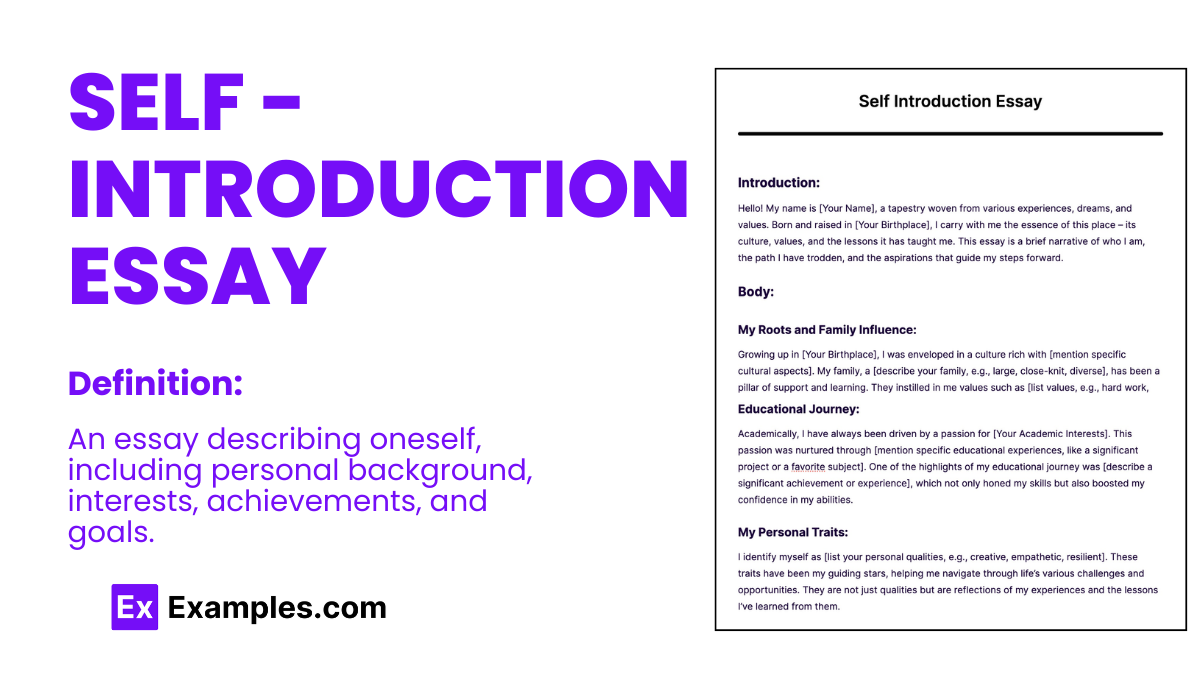
A Self Introduction Essay is a window into your personality, goals, and experiences. Our guide, supplemented with varied essay examples , offers insights into crafting a compelling narrative about yourself. Ideal for college applications, job interviews, or personal reflections, these examples demonstrate how to weave your personal story into an engaging essay. Learn to highlight your strengths, aspirations, and journey in a manner that captivates your readers, making your introduction not just informative but also memorable.
What is Self Introduction Essay? A self-introduction essay is a written piece where you describe yourself in a personal and detailed way. It’s a way to introduce who you are, including your name, background, interests, achievements, and goals. This type of essay is often used for college or job applications, allowing others to get to know you better. It’s an opportunity to showcase your personality, experiences, and what makes you unique. Writing a self-introduction essay involves talking about your educational background, professional experiences if any, personal interests, and future aspirations. It’s a chance to highlight your strengths, achievements, and to share your personal story in a way that is engaging and meaningful.
Do you still remember the first time you’ve written an essay ? I bet you don’t even know it’s called an “essay” back then. And back then you might be wondering what’s the purpose such composition, and why are you writing something instead of hanging out with your friends.
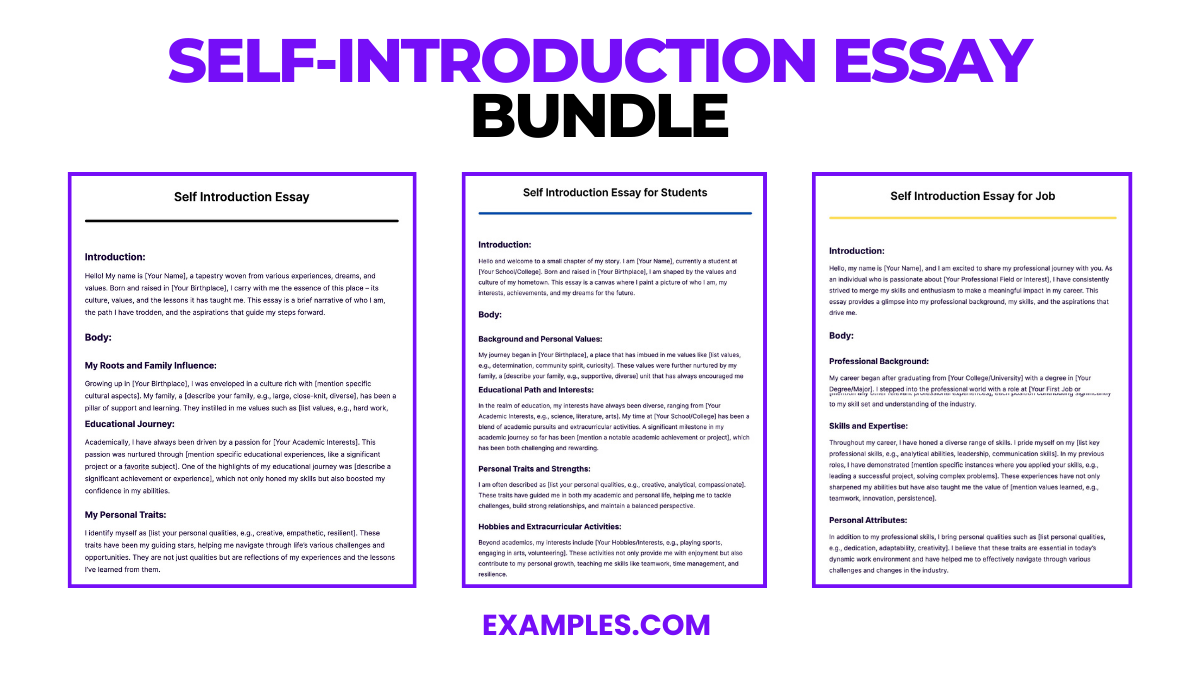
Download Self-Introduction Essay Bundle
Now, you probably are already familiar with the definition of an essay, and the basics of writing one. You’re also probably aware of the purpose of writing essays and the different writing styles one may use in writing a composition. Here, we will be talking about self-introduction essay, and look into different example such as personal essay which you may refer to.
Self Introduction Essay Format
Introduction.
Start with a hook: Begin with an interesting fact, a question, or a compelling statement about yourself to grab the reader’s attention. State your name and a brief background: Share your name, age, and where you’re from or what you currently do (student, job role).
Educational Background
Discuss your current or most recent educational experience: Mention your school, college, or university and your major or area of study. Highlight academic achievements or interests: Share any honors, awards, or special projects that are relevant to your personality or career goals.
Professional Background
Mention your current job or professional experiences: Briefly describe your role, company, or the type of work you do. Highlight relevant skills or achievements: Share experiences that showcase your abilities and contributions to your field.
Personal Interests and Goals
Share your hobbies or interests: Briefly describe activities you enjoy or passions you pursue outside of work or school. Discuss your short-term and long-term goals: Explain what you aim to achieve in the near future and your aspirations for the long term.
Summarize your strengths and what makes you unique: Reinforce key points about your skills, achievements, or character. Close with a statement on what you hope to achieve or contribute in your next role, educational pursuit, or personal endeavor.
Example of Self Introduction Essay in English
Hello! My name is Alex Johnson, a 21-year-old Environmental Science major at Green Valley University, passionate about sustainable living and conservation efforts. Raised in the bustling city of New York, I’ve always been fascinated by the contrast between urban life and the natural world, driving me to explore how cities can become more sustainable. Currently, in my final year at Green Valley University, I’ve dedicated my academic career to understanding the complexities of environmental science. My coursework has included in-depth studies on renewable energy sources, water conservation techniques, and sustainable agriculture. I’ve achieved Dean’s List status for three consecutive years and led a successful campus-wide recycling initiative that reduced waste by 30%. This past summer, I interned with the City Planning Department of New York, focusing on green spaces in urban areas. I worked on a project that aimed to increase the city’s green coverage by 10% over the next five years. This hands-on experience taught me the importance of practical solutions in environmental conservation and sparked my interest in urban sustainability. Beyond academics, I’m an avid hiker and nature photographer, believing strongly in the power of visual storytelling to raise awareness about environmental issues. My goal is to merge my passion for environmental science with my love for photography to create impactful narratives that promote conservation. In the future, I aspire to work for an NGO that focuses on urban sustainability, contributing to projects that integrate green spaces into city planning. I am also considering further studies in environmental policy, hoping to influence positive change on a global scale. My journey from a curious city dweller to an aspiring environmental scientist has been driven by a deep passion for understanding and protecting our natural world. With a solid educational foundation and practical experience, I am eager to contribute to meaningful environmental conservation efforts. I believe that by combining scientific knowledge with creative communication, we can inspire a more sustainable future for urban areas around the globe.
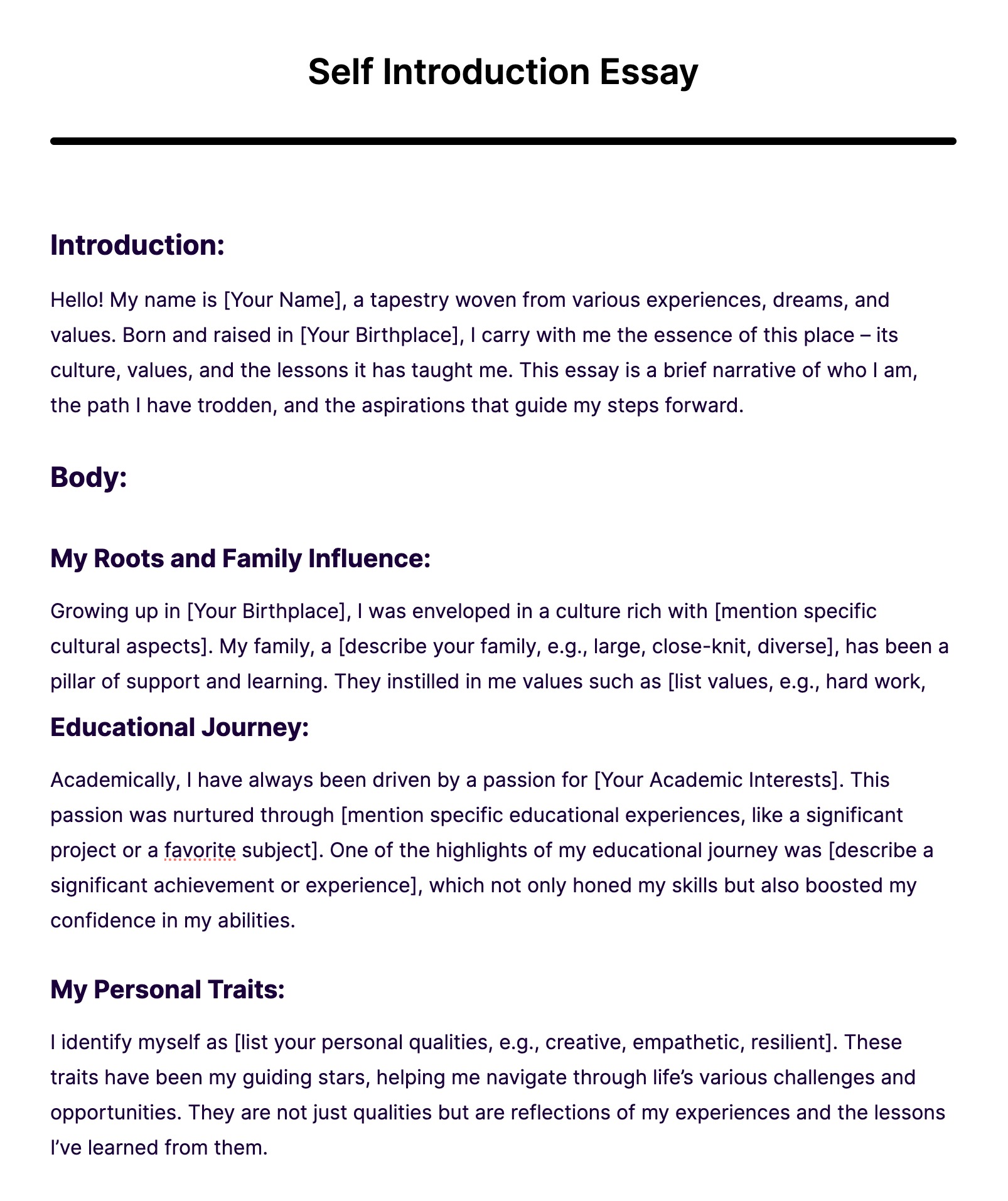
Self Introduction Essay for Job

Self Introduction Essay for Students
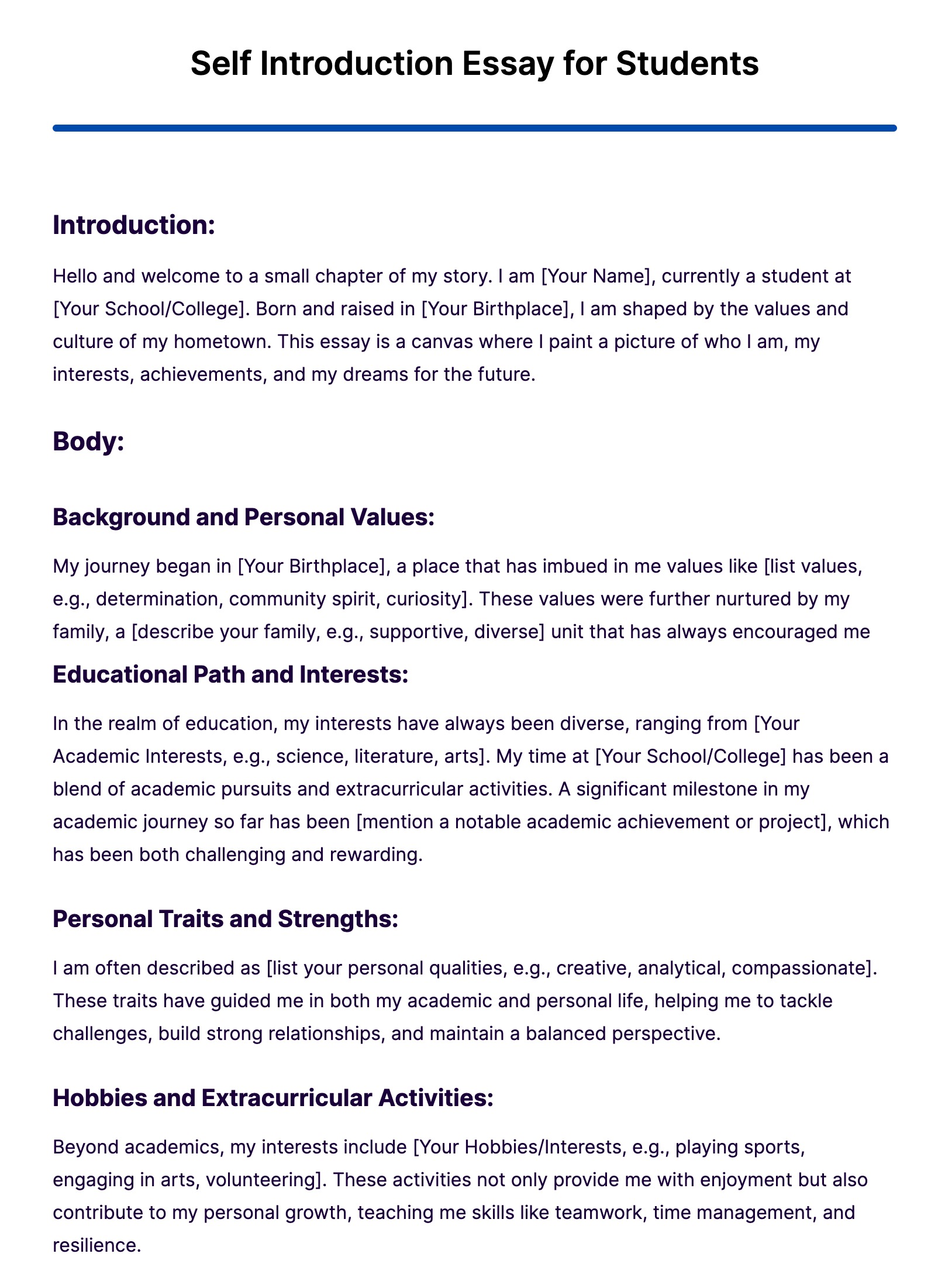
Self Introduction Essay Example

Size: 119 KB
Self Introduction For College Students Example

Size: MS Word
Simple Self Introduction For Job Example

Size: 88.4 KB
Free Self Introduction For Kids Example
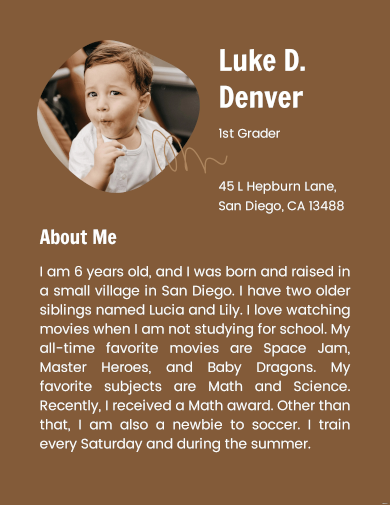
Size: 123 KB
Simple Self Introduction Example
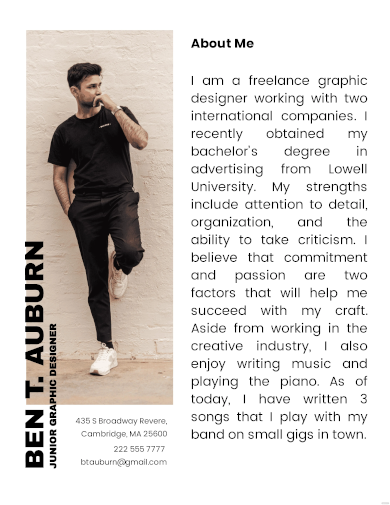
Size: 178 KB
Self Introduction For Freshers Example

Size: 96.2 KB
Free Self Introduction For Interview Example
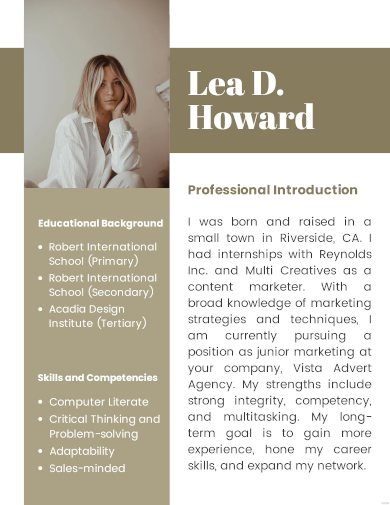
Size: 129 KB
Company Self Introduction Example
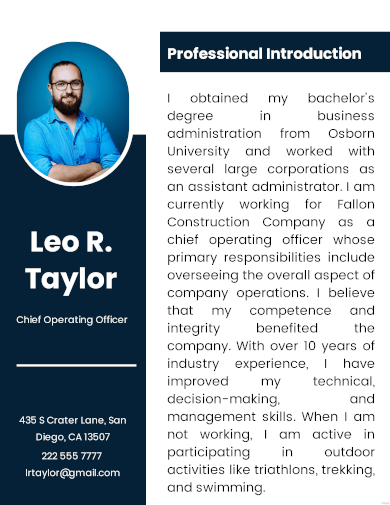
Size: 125 KB
Self Introduction For First Day At Work Sample

Size: 124 KB
Sample Self Introduction for Scholarship Example
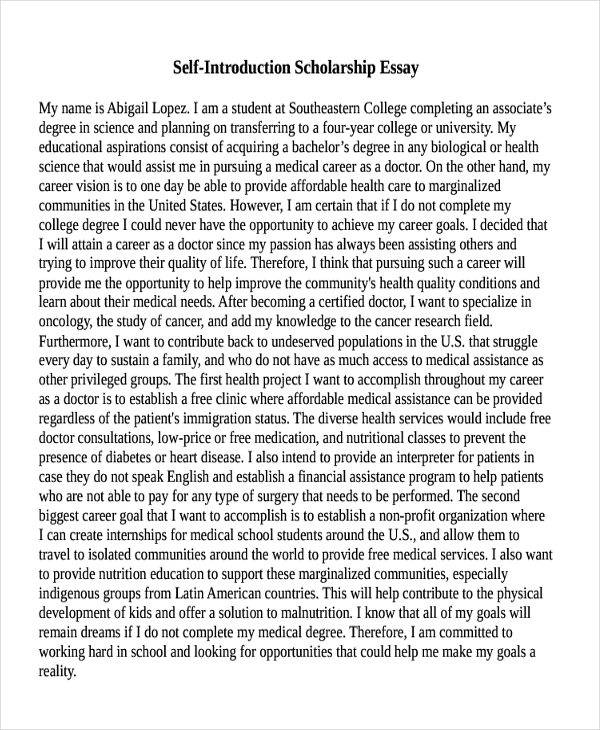
scholarshipsaz.org
Size: 33 KB
Free Self Introduction Sample Example
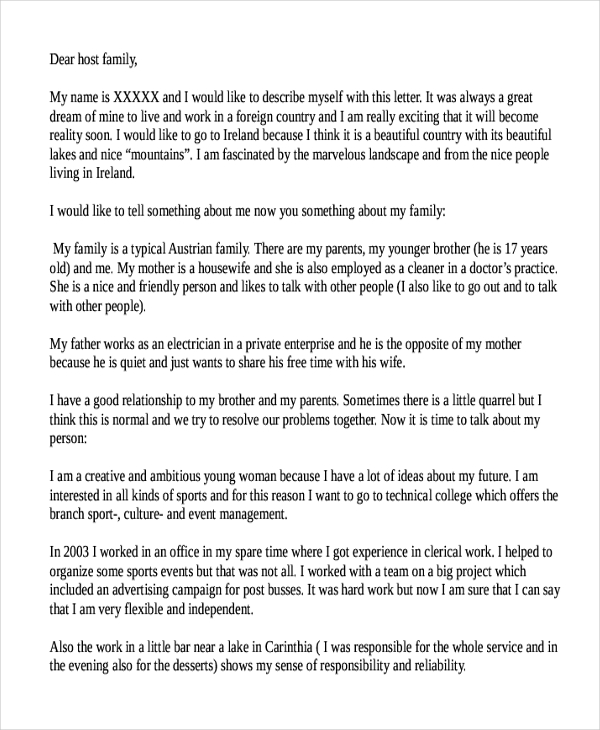
au-pair4you.at
Size: 22 KB
Creative Essay for Internship Example
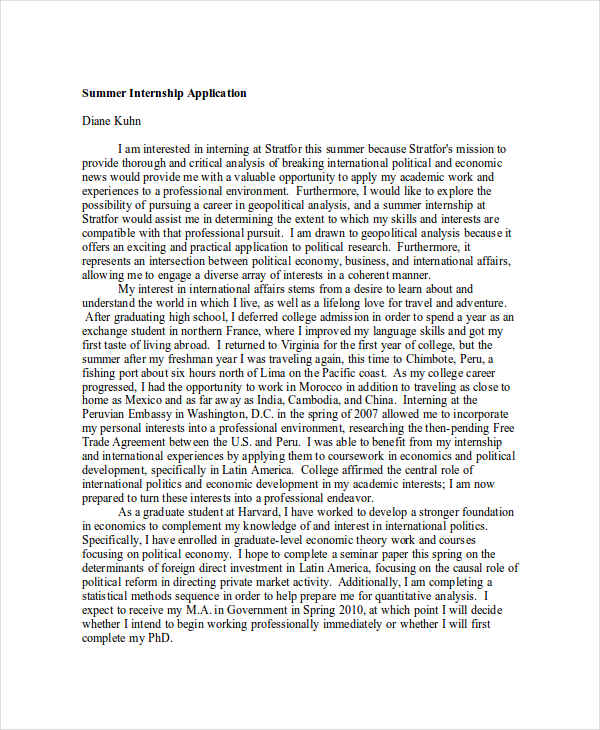
wikileaks.org
What to Write in a Self-Introduction Essay
A self-introduction essay, as the name suggest, is an part of an essay containing the basic information about the writer.
In writing a self-introduction essay, the writer intends to introduce himself/herself by sharing a few personal information including the basics (e.g. name, age, hometown, etc.), his/her background information (e.g. family background, educational background, etc.), and interesting facts about him/her (e.g. hobbies, interests, etc). A self-introductory essay primarily aims to inform the readers about a few things regarding the writer. You may also see personal essay examples & samples
How to Write a Self-Introduction Essay
A self-introduction essay is, in most cases, written using the first-person point of view. As a writer, you simply need to talk about yourself and nothing more to a specific audience. You may also like essay writing examples
A self-introduction essay can be easy to write, since all you have to do is to introduce yourself. However, one needs to avoid sounding like a robot or a person speaking in monotone. Of course, you need to make the composition interesting and engaging, instead of making it plain and bland. This is probably the main challenge of writing a self-introduction essay, and the first thing every writer needs to be aware of.
Free Essay Outline Worksheet Example

englishwithhallum.com
Size: 40 KB
Free Interesting Self Introduction for Student Example
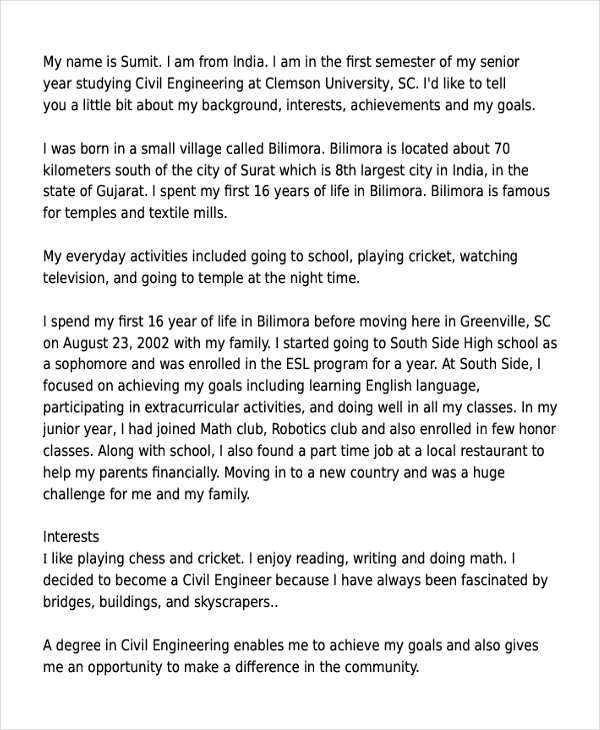
essayforum.com
Size: 14 KB
Free Attractive Introduction Essay for Interview Example
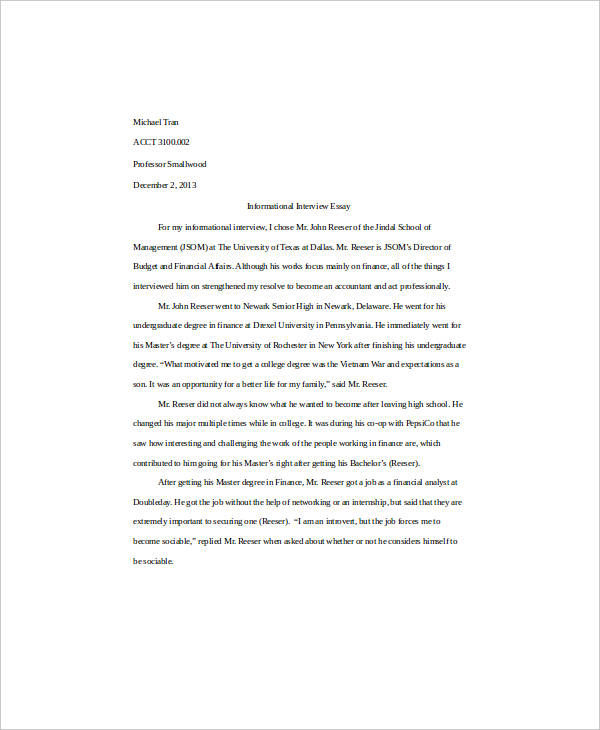
michaeltran27.weebly.com
Size: 17 KB
Formal Self Introduction Expository Example
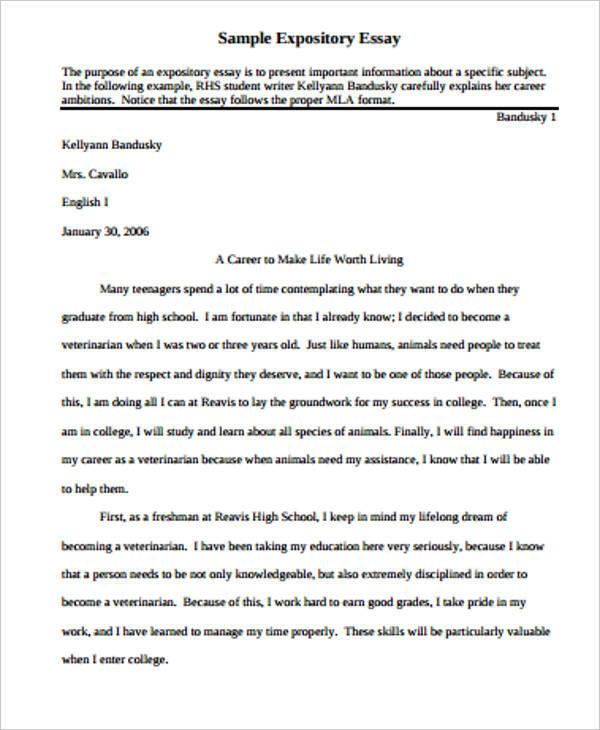
teacherweb.com
Uses of Self Introduction Essay
- College Applications : Many universities and colleges ask for a self-introduction essay as part of the application process. This essay allows admissions officers to learn more about your personality, background, and aspirations beyond your grades and test scores.
- Scholarship Applications : When applying for scholarships, a self-introduction essay can help you stand out. It’s an opportunity to share your achievements, experiences, and the reasons you deserve the scholarship.
- Job Interviews : Preparing a self-introduction essay can be useful for job interviews. It helps you articulate your professional background, skills, and career goals clearly and confidently.
- Networking : In professional networking situations, having a polished self-introduction essay can help you quickly share relevant information about yourself with potential employers, mentors, or colleagues.
- Personal Reflection : Writing a self-introduction essay is a valuable exercise in self-reflection. It can help you understand your own goals, strengths, and weaknesses better.
- Online Profiles : For personal or professional websites, social media, or portfolios, a self-introduction essay provides a comprehensive overview of who you are and what you offer, attracting potential connections or opportunities.
Tips for Writing a Self-Introduction Essay
A self-introduction essay might be one of the easiest essays to start. However, one needs to learn a few things to make the composition worth reading. You might find a lot of tips online on how to write a self-introduction essay, but here are some tips which you might find useful.
1. Think of a catchy title
The first thing that attracts readers is an interesting title, so create one.
2. Introduce yourself
You can create some guide questions to answer like: Who are you? What are your interests? What is your story? Simply talk about yourself like you’re talking to someone you just met.
3. Find a focus
Your life story is too broad, so focus on something, like: What makes you unique?
4. Avoid writing plainly
For example, instead of saying: ‘I like listening to classical music’, you can say: ‘My dad gave me an album containing classical music when I was five, and after listening to it, I was really captivated. I’ve loved it since then.’ You may also check out high school essay examples & samples
5. Simplify your work
Use simple words and language. Write clearly. Describe details vividly.
6. End it with a punch
You cannot just plainly say ‘The End’ at the last part. Create a essay conclusion which would leave an impression to your readers.
7. Edit your work
After wrapping up, take time to review and improve your work. You may also see informative essay examples & samples
What is a Creative Self Introduction Essay?
1. Choose a Theme or Metaphor:
Start with a theme or metaphor that reflects your personality or the message you want to convey. For example, you could compare your life to a book, a journey, or a puzzle.
2. Engaging Hook:
Begin with an attention-grabbing hook, such as a captivating anecdote, a thought-provoking question, a quote, or a vivid description.
3. Tell a Story:
Weave your self-introduction into a narrative or story that highlights your experiences, values, or defining moments. Storytelling makes your essay relatable and memorable.
4. Use Vivid Imagery:
Employ descriptive language and vivid imagery to paint a picture of your life and character. Help the reader visualize your journey.
5. Show, Don’t Tell:
Instead of simply listing qualities or achievements, demonstrate them through your storytelling. Show your resilience, creativity, or determination through the narrative.
6. Include Personal Anecdotes:
Share personal anecdotes that showcase your character, challenges you’ve overcome, or moments of growth.
7. Express Your Passions:
Discuss your passions, interests, hobbies, or aspirations. Explain why they are important to you and how they have influenced your life.
8. Reveal Vulnerability:
Don’t be afraid to show vulnerability or share setbacks you’ve faced. It adds depth to your story and demonstrates your resilience.
9. Highlight Achievements:
Mention significant achievements, awards, or experiences that have shaped your journey. Connect them to your personal growth and values.
10. Convey Your Personality:
Use humor, wit, or elements of your personality to make your essay unique and relatable. Let your voice shine through.
11. Share Future Aspirations:
Discuss your goals, dreams, and what you hope to achieve in the future. Explain how your experiences have prepared you for your next steps.
12. Conclude with a Message:
Wrap up your essay with a meaningful message or reflection that leaves a lasting impression on the reader.
13. Revise and Edit:
After writing your initial draft, revise and edit your essay for clarity, coherence, and conciseness. Ensure it flows smoothly.
How do you write an introduction to a self essay?
1. Start with a Hook:
Begin with an engaging hook to capture the reader’s attention. This could be a personal anecdote, a thought-provoking question, a quote, or a vivid description. The hook should relate to the essay’s theme.
2. Introduce Yourself:
After the hook, introduce yourself by stating your name and any relevant background information, such as your age, place of origin, or current location. This helps provide context.
3. Establish the Purpose:
Clearly state the purpose of your self-essay. Explain why you are writing it and what you aim to convey. Are you introducing yourself for a job application, a college admission essay, or a personal blog? Make this clear.
4. Provide a Preview:
Offer a brief preview of the main points or themes you will address in the essay. This helps set expectations for the reader and gives them an overview of what to anticipate.
5. Share Your Thesis or Central Message:
In some self-essays, especially in academic or personal development contexts, you may want to state a central message or thesis about yourself. This is the core idea you’ll explore throughout the essay.
6. Express Your Voice:
Let your unique voice and personality shine through in the introduction. Write in a way that reflects your style and character. Avoid using overly formal or stilted language if it doesn’t align with your personality.
7. Be Concise:
Keep the introduction relatively concise. It should provide an overview without delving too deeply into the details. Save the in-depth discussions for the body of the essay.
8. Revise and Edit:
After writing the introduction, review it for clarity, coherence, and conciseness. Make sure it flows smoothly and leads naturally into the main body of the essay.
Here’s an example of an introduction for a self-essay:
“Standing at the threshold of my college years, I’ve often found myself reflecting on the journey that brought me here. I am [Your Name], a [Your Age]-year-old [Your Origin or Current Location], with a passion for [Your Interests]. In this self-essay, I aim to share my experiences, values, and aspirations as I enter this new chapter of my life. Through personal anecdotes and reflections, I hope to convey the lessons I’ve learned and the person I’m becoming. My central message is that [Your Central Message or Thesis]. Join me as I explore the highs and lows of my journey and what it means to [Your Purpose or Theme].”
What is a short paragraph of self introduction
“Hello, my name is [Your Name], and I am [Your Age] years old. I grew up in [Your Hometown] and am currently studying [Your Major or Grade Level] at [Your School or University]. I have always been passionate about [Your Interests or Hobbies], and I love exploring new challenges and experiences. In my free time, I enjoy [Your Activities or Hobbies], and I’m excited to be here and share my journey with all of you.”
How do I start my self introduction?
1. Greet the Audience:
Start with a warm and friendly greeting. This sets a positive tone and makes you approachable.
Example: “Good morning/afternoon/evening!”
2. State Your Name:
Clearly and confidently state your name. This is the most basic and essential part of any self-introduction.
Example: “My name is [Your Name].”
3. Provide Additional Background Information:
Depending on the context, you may want to share additional background information. Mention where you are from, your current location, or your job title, if relevant.
Example: “I’m originally from [Your Hometown], but I currently live in [Your Current Location].”
4. Express Enthusiasm:
Express your enthusiasm or eagerness to be in the situation or context where you are introducing yourself.
Example: “I’m thrilled to be here today…”
5. State the Purpose:
Clearly state the purpose of your self-introduction. Are you introducing yourself for a job interview, a social gathering, or a specific event? Make it clear why you are introducing yourself.
Example: “…to interview for the [Job Title] position.”
6. Offer a Brief Teaser:
Give a brief teaser or hint about what you’ll be discussing. This can generate interest and set the stage for the rest of the introduction.
Example: “I’ll be sharing my experiences as a [Your Profession] and how my background aligns with the requirements of the role.”
7. Keep It Concise:
Keep your introduction concise, especially in professional settings. You can provide more details as the conversation progresses.
8. Be Confident and Maintain Eye Contact:
Deliver your introduction with confidence and maintain eye contact with the audience or the person you’re addressing.
How can I start my self introduction example?
Hi, I’m [Your Name]. It’s a pleasure to meet all of you. I come from [Your Hometown], and today, I’m excited to tell you a bit about myself. I have a background in [Your Education or Profession], and I’m here to share my experiences, skills, and passions. But before I dive into that, let me give you a glimpse into the person behind the resume. So, here’s a little about me…”
For more insights on crafting a compelling self-introduction, the University of Nevada, Reno’s Writing & Speaking Center provides valuable resources. These can enhance your essay-writing skills, especially in crafting introductions that make a lasting impression.
Self Introduction Essay Generator
Text prompt
- Instructive
- Professional
Write a Self Introduction Essay that highlights your unique qualities.
Create a Self Introduction Essay outlining your academic interests.
Self Introduction For Kids Example
Self Introduction For Freshers Example
Self Introduction For Interview Example
404 Not found
Have a language expert improve your writing
Check your paper for plagiarism in 10 minutes, generate your apa citations for free.
- Knowledge Base
- College essay
How to Write About Yourself in a College Essay | Examples
Published on September 21, 2021 by Kirsten Courault . Revised on May 31, 2023.
An insightful college admissions essay requires deep self-reflection, authenticity, and a balance between confidence and vulnerability. Your essay shouldn’t just be a resume of your experiences; colleges are looking for a story that demonstrates your most important values and qualities.
To write about your achievements and qualities without sounding arrogant, use specific stories to illustrate them. You can also write about challenges you’ve faced or mistakes you’ve made to show vulnerability and personal growth.
Table of contents
Start with self-reflection, how to write about challenges and mistakes, how to write about your achievements and qualities, how to write about a cliché experience, other interesting articles, frequently asked questions about college application essays.
Before you start writing, spend some time reflecting to identify your values and qualities. You should do a comprehensive brainstorming session, but here are a few questions to get you started:
- What are three words your friends or family would use to describe you, and why would they choose them?
- Whom do you admire most and why?
- What are the top five things you are thankful for?
- What has inspired your hobbies or future goals?
- What are you most proud of? Ashamed of?
As you self-reflect, consider how your values and goals reflect your prospective university’s program and culture, and brainstorm stories that demonstrate the fit between the two.
Prevent plagiarism. Run a free check.
Writing about difficult experiences can be an effective way to show authenticity and create an emotional connection to the reader, but choose carefully which details to share, and aim to demonstrate how the experience helped you learn and grow.
Be vulnerable
It’s not necessary to have a tragic story or a huge confession. But you should openly share your thoughts, feelings, and experiences to evoke an emotional response from the reader. Even a cliché or mundane topic can be made interesting with honest reflection. This honesty is a preface to self-reflection and insight in the essay’s conclusion.
Don’t overshare
With difficult topics, you shouldn’t focus too much on negative aspects. Instead, use your challenging circumstances as a brief introduction to how you responded positively.
Share what you have learned
It’s okay to include your failure or mistakes in your essay if you include a lesson learned. After telling a descriptive, honest story, you should explain what you learned and how you applied it to your life.
While it’s good to sell your strengths, you also don’t want to come across as arrogant. Instead of just stating your extracurricular activities, achievements, or personal qualities, aim to discreetly incorporate them into your story.
Brag indirectly
Mention your extracurricular activities or awards in passing, not outright, to avoid sounding like you’re bragging from a resume.
Use stories to prove your qualities
Even if you don’t have any impressive academic achievements or extracurriculars, you can still demonstrate your academic or personal character. But you should use personal examples to provide proof. In other words, show evidence of your character instead of just telling.
Many high school students write about common topics such as sports, volunteer work, or their family. Your essay topic doesn’t have to be groundbreaking, but do try to include unexpected personal details and your authentic voice to make your essay stand out .
To find an original angle, try these techniques:
- Focus on a specific moment, and describe the scene using your five senses.
- Mention objects that have special significance to you.
- Instead of following a common story arc, include a surprising twist or insight.
Your unique voice can shed new perspective on a common human experience while also revealing your personality. When read out loud, the essay should sound like you are talking.
If you want to know more about academic writing , effective communication , or parts of speech , make sure to check out some of our other articles with explanations and examples.
Academic writing
- Writing process
- Transition words
- Passive voice
- Paraphrasing
Communication
- How to end an email
- Ms, mrs, miss
- How to start an email
- I hope this email finds you well
- Hope you are doing well
Parts of speech
- Personal pronouns
- Conjunctions
First, spend time reflecting on your core values and character . You can start with these questions:
However, you should do a comprehensive brainstorming session to fully understand your values. Also consider how your values and goals match your prospective university’s program and culture. Then, brainstorm stories that illustrate the fit between the two.
When writing about yourself , including difficult experiences or failures can be a great way to show vulnerability and authenticity, but be careful not to overshare, and focus on showing how you matured from the experience.
Through specific stories, you can weave your achievements and qualities into your essay so that it doesn’t seem like you’re bragging from a resume.
Include specific, personal details and use your authentic voice to shed a new perspective on a common human experience.
Cite this Scribbr article
If you want to cite this source, you can copy and paste the citation or click the “Cite this Scribbr article” button to automatically add the citation to our free Citation Generator.
Courault, K. (2023, May 31). How to Write About Yourself in a College Essay | Examples. Scribbr. Retrieved April 2, 2024, from https://www.scribbr.com/college-essay/write-about-yourself/
Is this article helpful?

Kirsten Courault
Other students also liked, style and tone tips for your college essay | examples, what do colleges look for in an essay | examples & tips, how to make your college essay stand out | tips & examples, "i thought ai proofreading was useless but..".
I've been using Scribbr for years now and I know it's a service that won't disappoint. It does a good job spotting mistakes”

5 Steps To Write An Essay About Yourself

Writing essays and academic papers are two such responsibilities for which students often face challenges throughout their academic life.
In fact, self-introduction essays are among the most typical assignments students confront among the many other essays.
Writing an essay about yourself necessitates you to possess excellent writing and storytelling abilities.
To produce a great personal essay, students must devote time, patience, and work. This article will educate you on how to write an essay on yourself, your family, a personal experience, and so on.
However, if you are time-pressed and unable to compose an essay, there are services that write same-day essays for students too.
When Might You Need to Write About Yourself?
Self-introduction essays or writing an essay about yourself is required during various circumstances of your academic and professional life.
Aside from the obvious cases, such as a personal statement or self-evaluations/appraisals, here are other situations where you’ll be required to write an essay about yourself:
- For graduation school applications
- When writing biographies
- For career advancement opportunities
- In cover letters and resumes
- Seeking internship opportunities
- In grant proposals
Most people think that writing an essay about yourself is one of the easiest tasks to do. Nonetheless, that may not be the case for most students.
One must possess good college writing skills to put their best foot forward and impress the reader to stand out among their peers. And here’s how you can do it correctly and confidently.
What Must the Self-Introduction Essay Include?
Writing an essay about yourself is a perfect opportunity to write about your strengths, achievements, and unique characteristics that provide an insight into yourself.
You may be confused about what exactly to write or express in your self-introduction essay. So, in this post, we will explain what you can write about yourself that will help you score brownie points and stand out amidst the competition.
Also, check out these examples and samples on self-introductory essays .
For instance, when writing about yourself, consider your path and the things that have shaped you into the person you are. You can also write about various things such as:
- Your hobbies
- Your aspirations and dreams
- The things you want to learn
- The things you are best at
How to Write an Essay
Before composing an essay, understand the basic structure and prepare an outline to avoid any mistakes down the road.
So if you are wondering how to structure an essay, remember that all essays follow a basic structure – introduction, the body, and conclusion.
Introduction
This is the first part of the essay, and it must pique the reader’s interest. You must add a ‘hook’ here to keep the reader glued.
You must provide a thesis statement at the beginning of your writing that exhibits the main idea of your essay.
Overall, the introduction must provide a brief overview of the entire essay in an engaging way.
The section contains a minimum of three paragraphs that explain the major themes or story of the essay. Ensure that each paragraph connects smoothly with the next. It is best to write in chronological order to avoid confusion.
This is the last paragraph or last section of the essay, and it must logically conclude your story. Here you can highlight the lesson you’ve gained throughout your experience. It is better to keep this section short.
Essay Structure
This is the basic structure that one must follow when writing an essay. Once you understand the essay format, create an outline that includes:
- An introduction about yourself
- Your most significant professional experience
- Noteworthy awards or personal accomplishments
- Relevant information about your personal life
Note: Make sure you use an appropriate tone if it is not mentioned. While an informal tone is used when writing about personal experiences, remember not to use any ‘slang’ words that might look unprofessional.
Steps to Writing an Effective Essay

Use particular anecdotes to highlight your accomplishments and traits without appearing pretentious.
You can also write about difficulties you’ve encountered or mistakes you’ve made to demonstrate vulnerability and personal progress.
1. Self-Reflection
The first step is to reflect on the topic before you begin writing to determine what you want to include in your essay.
Having a thorough brainstorming session can help a lot. However, here are a few starter questions that can help you:
- What has influenced your hobbies or future ambitions?
- What are you most pleased with?
- Why do you look up to someone in particular?
- Consider how your values and aspirations mirror your target university’s program and culture as you self-reflect. Develop tales that highlight the fit between the two.
2. Write Something Extraordinary
Using the questions above, pick an incident or some strong point about yourself to elucidate.
Remember that you must write about a single incident or quality that makes you stand out. Avoid talking about two qualities or two incidents.
3. Define the Goal
Read the essay guidelines and align your writing with that. The goal of your essay must reflect well in your words.
4. Know Your Audience
Think about your audience’s expectations and interests. It is critical to capture their attention and keep them reading your work until the finish.
5. Detailed Outline
The outline must be detailed and include all significant points.
Once the outline is ready, you can expand it into a full-fledged essay using the vital points. After completing the essay, proofread for typos and grammatical errors to ensure there are no mistakes.
These are the steps that college students can follow when writing self-introduction essays.
The first step to writing a successful essay is selecting an incident or quality that you want to write about.
It is recommended that you brainstorm the ideas and create an outline to avoid mishaps later.
You may also like

Seven Ways to Make your College Essay Stand Out

Thank You Notes: Following Up After a College Interview

8 Differences Between Aussie and American Schools

Example of a College Essay that Needs Revision

Preparing the Best Answers for College Interview Questions

Top 5 Most Difficult IB (International Baccalaureate) Subjects
About the author.

CB Community
Passionate members of the College Basics community that include students, essay writers, consultants and beyond. Please note, while community content has passed our editorial guidelines, we do not endorse any product or service contained in these articles which may also include links for which College Basics is compensated.

25,000+ students realised their study abroad dream with us. Take the first step today
Meet top uk universities from the comfort of your home, here’s your new year gift, one app for all your, study abroad needs, start your journey, track your progress, grow with the community and so much more.

Verification Code
An OTP has been sent to your registered mobile no. Please verify

Thanks for your comment !
Our team will review it before it's shown to our readers.

- Interview Preparation /
Best Ways to Introduce Yourself in an Essay
- Updated on
- May 1, 2023

A self-introduction essay is something in which an individual has to describe themselves in brief. Introducing yourself in an essay is generally part of academics in school or at any entrance exam . These self-introduction essays can also come in handy in your job interview, university admission, or self-appraisal opportunities.
In such cases, people struggle to write a simple essay about themselves. In this type of essay, the author may discuss their personal background, education, career goals , interests, hobbies , or any other information that they feel is relevant to give the reader a better understanding of who they are as a person. The essay may be written in the first person and can range from a few paragraphs to a few pages in length. A self-introduction essay should be concise, well-organized, and engaging to capture the reader’s attention.
In this blog, we will shed light on some of the best ways to introduce yourself in an essay.
This Blog Includes:
Uses of self introduction essay, things to remember while writing an introduction essay, best way to introduce yourself in an essay: sample.
Also Read: Top 5 Types of Writing
A self-introduction essay is a short piece of writing in which an individual introduces themselves to the reader. You can be asked to write about yourself in various situations, such as:
Job applications: Some job applications require you to write a personal statement or a cover letter where you introduce yourself and highlight your skills, experience, and qualifications.
College applications: College applications often include an essay prompt that asks you to write about yourself, your background, and your future goals.
Scholarship applications: Scholarships often require applicants to write essays about themselves, their academic achievements, and their financial need.
Personal blogs or websites: If you have a personal blog or website, you may choose to write about yourself as a way to introduce yourself to your readers.
Social media profiles: You may be asked to write a bio or an introduction for your social media profiles, such as LinkedIn, Twitter, or Instagram.
Networking events: In networking events or professional meetings, you may be asked to introduce yourself briefly and share your background, interests, and goals.
When writing a self-introduction essay, it is important to keep the following things in mind:
Keep it concise: An introduction essay should be brief and to the point. Focus on the most important aspects of yourself that you want to highlight.
Be honest: While it may be tempting to embellish your accomplishments, it is important to be truthful in your writing.
Show your personality: Use your writing to showcase your personality and what makes you unique. This will help you stand out from other applicants.
Use a strong opening: Start your essay with a strong opening sentence that captures the reader’s attention and makes them want to keep reading.
Use examples: Use specific examples to illustrate your points and to provide evidence for your claims.
Keep your audience in mind: Consider who your audience is and what they are looking for in a self-introduction essay. Tailor your writing to their expectations and needs.
Edit and proofread: Finally, make sure to edit and proofread your essay carefully to avoid any grammatical errors or typos that could detract from your message.
When introducing oneself in an essay, it’s important to strike a balance between being engaging and informative. Here’s a sample introduction that you can use as a guide:
Hello, my name is Jane and I’m thrilled to have the opportunity to introduce myself in this essay. I’m a recent graduate of XYZ University, where I earned a Bachelor’s degree in English Literature. During my time at university, I developed a passion for exploring the nuances of language and the power of storytelling. Aside from my academic pursuits, I’m an avid traveller and have been fortunate enough to visit several countries across the globe. I’m also a self-proclaimed foodie and love experimenting with new recipes in the kitchen. In this essay, I hope to share my thoughts and insights on the role of literature in shaping our worldview. Through personal anecdotes and literary analysis, I aim to demonstrate the transformative power of storytelling and how it can help us better understand ourselves and the world around us. Thank you for taking the time to get to know me a little better. I hope you find my essay both informative and thought-provoking.
Related Articles
This can be a great way to introduce yourself to others in a personal, engaging manner. Start with an engaging opening sentence, state details like your name, age, where you are from, and highlight some of your key life experiences that have shaped your values, beliefs, or perspective on life, etc.
A self-introduction essay can be used in multiple places, such as job and college applications, personal blogs or websites, social media profiles, networking events, etc.
Start by greeting the other person and stating your details, such as your name, age, qualifications, etc. Whenever you are introducing yourself, you need to keep a couple of things in mind: keep it concise, be real, use appropriate body language, and your words must portray your personality. To make it interesting, you can highlight real-life examples and how you managed to solve your past problems.
For the latest blogs on Interview Preparation, Careers, and more, follow the Leverage Edu website and YouTube channel .
Aditi Gupta
A bachelors in Journalism and Mass Communication graduate, I am an enthusiastic writer. I love to write about impactful content which can help others. I love to binge watch and listen to music during my free time.
Leave a Reply Cancel reply
Save my name, email, and website in this browser for the next time I comment.
Contact no. *

Leaving already?
8 Universities with higher ROI than IITs and IIMs
Grab this one-time opportunity to download this ebook
Connect With Us
25,000+ students realised their study abroad dream with us. take the first step today..

Resend OTP in

Need help with?
Study abroad.
UK, Canada, US & More
IELTS, GRE, GMAT & More
Scholarship, Loans & Forex
Country Preference
New Zealand
Which English test are you planning to take?
Which academic test are you planning to take.
Not Sure yet
When are you planning to take the exam?
Already booked my exam slot
Within 2 Months
Want to learn about the test
Which Degree do you wish to pursue?
When do you want to start studying abroad.
January 2024
September 2024
What is your budget to study abroad?

How would you describe this article ?
Please rate this article
We would like to hear more.
Have something on your mind?

Make your study abroad dream a reality in January 2022 with
India's Biggest Virtual University Fair

Essex Direct Admission Day
Why attend .

Don't Miss Out
404 Not found

Effective Self-Introductions (Inspiring Examples and Scripts)
By Status.net Editorial Team on September 22, 2023 — 21 minutes to read
- Structure of a Good Self-introduction Part 1
- Examples of Self Introductions in a Job Interview Part 2
- Examples of Self Introductions in a Meeting Part 3
- Examples of Casual Self-Introductions in Group Settings Part 4
- Examples of Self-Introductions on the First Day of Work Part 5
- Examples of Good Self Introductions in a Social Setting Part 6
- Examples of Good Self Introductions on Social Media Part 7
- Self-Introductions in a Public Speaking Scenario Part 8
- Name-Role-Achievements Method Template and Examples Part 9
- Past-Present-Future Method Template and Examples Part 10
- Job Application Self-Introduction Email Example Part 11
- Networking Event Self-Introduction Email Example Part 12
- Conference Self-Introduction Email Example Part 13
- Freelance Work Self-Introduction Email Example Part 14
- New Job or Position Self-Introduction Email Example Part 15
Whether you’re navigating a job interview, networking event, or simply meeting new people, the way you introduce yourself sets the tone for the entire interaction. In this comprehensive guide, we’ll equip you with the essential tools and techniques to confidently and effectively introduce yourself in any situation, leaving a lasting and positive impression.
Part 1 Structure of a Good Self-introduction
- 1. Greeting and introduction: Start by greeting the person you’re speaking to and introducing yourself. For example, “Hi, my name is Jane. Nice to meet you!”
- 2. Brief personal background: Give a brief overview of your personal background, such as where you’re from or what you do. For example, “I’m originally from California, but I moved to New York a few years ago. I work in marketing for a tech company.” Related: 10 Smart Answers: “Tell Me About Yourself”
- 3. Professional experience: Highlight your relevant professional experience, including your current or previous job titles and any notable achievements. For example, “I’ve been working in marketing for about 5 years now, and I’m currently a Senior Marketing Manager at my company. Last year, I led a successful campaign that resulted in a 20% increase in sales.” Related: How to Describe Yourself (Best Examples for Job Interviews)
- 4. Skills and strengths: Mention any skills or strengths that are relevant to the conversation or the situation you’re in. For example, “I’m really passionate about data analysis and using insights to inform marketing strategy. I’m also a strong communicator and enjoy collaborating with cross-functional teams.” Related: 195 Positive Words to Describe Yourself [with Examples] 35 Smart Answers to “What Are Your Strengths?” What Are Your Strengths And Weaknesses? (Answers & Strategies)
- 5. Personal interests: Wrap up your self-introduction by mentioning a few personal interests or hobbies, which can help to humanize you and make you more relatable. For example, “In my free time, I love hiking and exploring new trails. I’m also a big fan of trying out new restaurants and cooking at home.”
- Related: Core Values List: 150+ Awesome Examples of Personal Values Best Examples of “Fun Facts About Me” What Are Your Values? How to Discover Your Values
Part 2 Examples of Good Self Introductions in a Job Interview
When introducing yourself in an interview, you should be confident, clear, and knowledgeable. Maintain eye contact, speak with a steady tone, and be concise. Prepare your introduction beforehand to avoid stumbling or getting too wordy. Try to cover these aspects:
- Current or most recent position/job
- A relevant accomplishment or strength
- Why you are excited about the company or role
Templates and Scripts
“Hello, my name is [Your Name], and I recently worked as a [Your Most Recent Position] at [Company/Organization]. I successfully managed a team of [Number] members, achieving a [Relevant Accomplishment or Growth]. I’m excited about the opportunity at [Interviewer’s Company] because [Reason Why You’re Interested].”
“Hi, I’m [Your Name], a [Current Job Title or Major Accomplishment]. I’m passionate about [Relevant Industry or Skillset] and have a proven track record of [Specific Result or Achievement]. I believe my skills and experience make me well-suited for this role at [Company], and I’m excited to explore how I can contribute to [Company Goal or Project].”
“Hi, my name is Jane Doe, and I’m the Assistant Marketing Manager at ABC Corp. I recently implemented a successful social media campaign, which increased engagement by 30%. I’m thrilled about the possibility of working with XYZ Inc. because of your innovative marketing strategies.”
“Hello, I’m John Smith, a financial analyst with five years of experience in the banking industry. I’ve consistently exceeded sales targets and helped my team win an award for excellent customer service. I’m excited to join DEF Ltd. because of your focus on sustainable and responsible investing.”
Remember to tailor your introduction to the specific interview situation and always show enthusiasm for the position and company. This will show the interviewer that you are the right fit.
Related: How to Describe Yourself (Best Examples for Job Interviews)
Part 3 Examples of Good Self Introductions in a Meeting
General tips.
When introducing yourself in a meeting, consider these tips:
- Start with a greeting: Begin with a simple “hello” or “good morning.”
- State your name clearly: Don’t assume everyone knows you already.
- Mention your role in the company: Help others understand your position.
- Share relevant experience or accomplishments: Give context to your expertise.
- Be brief: Save detailed explanations for later conversations.
- Show enthusiasm: Display interest in the meeting and its objectives.
- Welcome others: Encourage a sense of connection and camaraderie.
Here are some templates and scripts to use when introducing yourself in a meeting:
- Basic introduction : Hi, I’m [Name], and I work as a [Your Role] in the [Department]. It’s great to meet you all.
- Involvement-focused : Good morning, everyone. I’m [Name], [Your Role]. I handle [Responsibility] in our team, and I’m looking forward to working with you on [Project].
- Experience-based : Hello! My name is [Name] and I’m the [Your Role] here. I’ve [Number of Years] of experience in [Skills or Industry], so I hope to contribute to our discussions during the meeting.
Here are some examples of self-introductions in different scenarios:
- New team member : Hi, I’m [Name]. I just joined the [Department] team as the new [Your Role]. I have a background in [Relevant Experience] and am excited to start working with you on our projects!
- External consultant : Hello everyone, my name is [Name], and I’m here in my capacity as a [Your Role] with [Your Company]. I specialize in [Skill or Industry], and I’m looking forward to partnering with your team to achieve our goals.
- Guest speaker : Good morning, I’m [Name], a [Your Position] at [Organization]. I have expertise in [Subject], and I’m honored to be here today to share my insights with you.
Related: 10 Smart Answers: “Tell Me About Yourself”
Part 4 Examples of Casual Self-Introductions in Group Settings
Template 1:.
“Hi, I’m [your name], and I’m a [profession or role]. I love [personal hobby or interest].”
“Hi, I’m Emily, and I’m a pediatric nurse. I love gardening and spending my weekends tending to my colorful flower beds.”
“Hello, I’m Mark, and I work as a data analyst. I love reading science fiction novels and discussing the intricacies of the stories with fellow book enthusiasts.”
“Hey there, I’m Jessica, and I’m a chef. I have a passion for traveling and trying new cuisines from around the world, which complements my profession perfectly.”
Template 2:
“Hey everyone, my name is [your name]. I work as a [profession or role], and when I’m not doing that, I enjoy [activity].”
“Hey everyone, my name is Alex. I work as a marketing manager, and when I’m not doing that, I enjoy hiking in the wilderness and capturing the beauty of nature with my camera.”
“Hello, I’m Michael. I work as a software developer, and when I’m not coding, I enjoy playing chess competitively and participating in local tournaments.”
“Hi there, I’m Sarah. I work as a veterinarian, and when I’m not taking care of animals, I enjoy painting landscapes and creating art inspired by my love for wildlife.”
“Hi there! I’m [your name]. I’m currently working as a [profession or role], and I have a passion for [hobby or interest].”
“Hi there! I’m Rachel. I’m currently working as a social worker, and I have a passion for advocating for mental health awareness and supporting individuals on their journeys to recovery.”
“Hello, I’m David. I’m currently working as a financial analyst, and I have a passion for volunteering at local animal shelters and helping rescue animals find their forever homes.”
“Hey, I’m Lisa. I’m currently working as a marine biologist, and I have a passion for scuba diving and exploring the vibrant underwater ecosystems that our oceans hold.”
Related: 195 Positive Words to Describe Yourself [with Examples]
Part 5 Examples of Good Self-Introductions on the First Day of Work
On your first day of work, it’s crucial to make a good impression with a well-crafted self-introduction. Keep it brief and concise, focusing on your name, role, and background. Make sure to smile, maintain eye contact, and exude confidence. It’s fine to share a little about your personal life, but avoid oversharing.
Here are some templates and scripts to help guide your self-introduction:
- Simple Introduction : “Hi, my name is [Your name], and I’m the new [Your position] here. I recently graduated from [Your university or institution] and am excited to join the team. I’m looking forward to working with you all.”
- Professional Background : “Hello everyone, I’m [Your name]. I’ve joined as the new [Your position]. With my background in [Your skills or experience], I’m eager to contribute to our projects and learn from all of you. Don’t hesitate to reach out if you have any questions.”
- Personal Touch : “Hey there! I’m [Your name], and I’ve recently joined as the new [Your position]. On the personal side, I enjoy [Your hobbies] during my free time. I’m looking forward to getting to know all of you and working together.”
Feel free to tweak these scripts as needed to fit your personality and work environment.
Here are some specific examples of self-introductions on the first day of work:
- Marketing Manager : “Hi, my name is Alex, and I’m excited to be the new Marketing Manager here. I’ve been in the marketing industry for five years and have worked on various campaigns. Outside of work, I love exploring new hiking trails and photography. I can’t wait to collaborate with you all.”
- Software Engineer : “Hello, I’m Priya, your new Software Engineer. I graduated from XYZ University with a degree in computer science and have experience in Python, Java, and web development. In my free time, I enjoy playing the guitar and attending live concerts. I’m eager to contribute to our team’s success and learn from all of you.”
Related: Core Values List: 150+ Awesome Examples of Personal Values
Part 6 Examples of Good Self Introductions in a Social Setting
When introducing yourself in a social setting, it’s crucial to create a positive impression. Keep your body language open and approachable, maintain eye contact, smile, and project confidence. Start with a greeting and follow up with your name. Share something interesting or unique about yourself to engage others in conversation, but avoid oversharing or dominating the conversation. Listen actively and show interest in others, asking questions and seeking common ground.
Here are some templates and scripts to help with your self-introduction in various social settings:
Casual gatherings: “Hi, I’m [Name]. Nice to meet you! I’m a huge fan of [hobby]. How about you, what do you enjoy doing in your free time?”
Networking events: “Hello, I’m [Name] and I work as a [profession] at [company]. I’m excited to learn more about what everyone here does. What brings you here today?”
Parties at a friend’s house: “Hi there, my name is [Name]. I’m a friend of [host’s name] from [work/school/etc]. How do you know [host’s name]?”
Here are some examples of self-introductions in various social settings:
- Casual gathering: “Hey, my name is Jane. Great to meet you! I love exploring new coffee shops around the city. What’s your favorite thing to do on weekends?”
- Networking event: “Hi, I’m John, a website developer at XY Technologies. I’m eager to connect with people in the industry. What’s your field of expertise?”
- Party at a friend’s house: “Hello, I’m Laura. I met our host, Emily, in our college photography club. How did you and Emily become friends?”
Related: Best Examples of “Fun Facts About Me”
Part 7 Examples of Good Self Introductions on Social Media
When introducing yourself on social media, keep it concise, personable, and informative. Showcase your personality while maintaining a professional tone. To stand out, include unique interests or hobbies, and highlight your skills or achievements.
- Keep it brief: Social media is fast-paced, so stick to the essentials and keep your audience engaged.
- Show your personality: Let your audience know who you are beyond your job title or education.
- Include a call-to-action: Encourage your followers to engage with you by asking a question or directing them to your website or other social media profiles.
Template 1: Brief and professional
Hi, I’m [Your Name]. I’m a [Job Title/Field] with a passion for [Interests or Hobbies]. Connect with me to chat about [Subject Matter] or find more of my work at [Website or Social Media Handle].
Template 2: Casual and personal
Hey there! I’m [Your Name] and I love all things [Interest or Hobby]. In my day job, I work as a [Job Title/Field]. Let’s connect and talk about [Shared Interest] or find me on [Other Social Media Platforms]!
Template 3: Skill-focused
Hi, I’m [Your Name], a [Job Title/Field] specializing in [Skills or Expertise]. Excited to network and share insights on [Subject Matter]. Reach out if you need help with [Skill or Topic] or want to discuss [Related Interest]!
Example 1: Brief and professional
Hi, I’m Jane Doe. I’m a Marketing Manager with a passion for photography and blogging. Connect with me to chat about the latest digital marketing trends or find more of my work at jdoephotography.com.
Example 2: Casual and personal
Hey there! I’m John Smith and I love all things coffee and travel. In my day job, I work as a software developer. Let’s connect and talk about adventures or find me on Instagram at @johnsmithontour!
Example 3: Skill-focused
Hi, I’m Lisa Brown, a Graphic Designer specializing in branding and typography. Excited to network and share insights on design. Reach out if you need help with creating visually appealing brand identities or want to discuss minimalistic art!
Part 8 Self-Introductions in a Public Speaking Scenario
When introducing yourself in a public speaking scenario, maintain eye contact, speak clearly, and show enthusiasm. Keep it concise, focusing on your background and what you bring to the table. Stay genuine, along with sharing something relatable or interesting about yourself to form an emotional connection.
- Professional introduction: “Hello, my name is [Your Name], and I have [number of years] of experience working in [your field]. Throughout my career, I have [briefly mention one or two significant accomplishments]. Today, I am excited to share [the main point of your presentation].”
- Casual introduction: “Hey everyone, I’m [Your Name], and I [briefly describe yourself, e.g., your hobbies or interests]. I’m really thrilled to talk to you about [the main point of your presentation]. Let’s dive right into it!”
- Creative introduction: “Imagine [paint a visual with a relevant story]. That’s where my passion began for [the main point of your presentation]. My name is [Your Name], and [mention relevant background/information].”
- Professional introduction: “Hello, my name is Jane Smith, and I have 15 years of experience working in marketing and advertisement. Throughout my career, I have helped companies increase their revenue by up to 50% using creative marketing strategies. Today, I am excited to share my insights in implementing effective social media campaigns.”
- Casual introduction: “Hey everyone, I’m John Doe, and I love hiking and playing the guitar in my free time. I’m really thrilled to talk to you about the impact of music on mental well-being, a topic close to my heart. Let’s dive right into it!”
- Creative introduction: “Imagine standing at the edge of a cliff, looking down at the breathtaking view of nature. That’s where my passion began for landscape photography. My name is Alex Brown, and I’ve been fortunate enough to turn my hobby into a successful career. Today, I’ll share my expertise on capturing stunning images with just a few simple techniques.”
Effective Templates for Self-Introductions
Part 9 name-role-achievements method template and examples.
When introducing yourself, consider using the NAME-ROLE-ACHIEVEMENTS template. Start with your name, then mention the role you’re in, and highlight key achievements or experiences you’d like to share.
“Hello, I’m [Your Name]. I’m currently working as a [Your Current Role/Position] with [Your Current Company/Organization]. Some of my key achievements or experiences include [Highlight 2-3 Achievements or Experiences].”
“Hello, I’m Sarah Johnson. I’m a Senior Software Engineer with over 10 years of experience in the tech industry. Some of my key achievements include leading a cross-functional team to develop a groundbreaking mobile app that garnered over 5 million downloads and receiving the ‘Tech Innovator of the Year’ award in 2020.”
“Hi there, my name is [Your Name]. I serve as a [Your Current Role] at [Your Current Workplace]. In my role, I’ve had the opportunity to [Describe What You Do]. One of my proudest achievements is [Highlight a Significant Achievement].”
“Hi there, my name is David Martinez. I currently serve as the Director of Marketing at XYZ Company. In my role, I’ve successfully executed several high-impact marketing campaigns, resulting in a 30% increase in brand visibility and a 15% boost in revenue last year.”
Template 3:
“Greetings, I’m [Your Name]. I hold the position of [Your Current Role] at [Your Current Company]. With [Number of Years] years of experience in [Your Industry], I’ve had the privilege of [Mention a Notable Experience].”
“Greetings, I’m Emily Anderson. I hold the position of Senior Marketing Manager at BrightStar Solutions. With over 8 years of experience in the technology and marketing industry, I’ve had the privilege of spearheading the launch of our flagship product, which led to a 40% increase in market share within just six months.”
Part 10 Past-Present-Future Method Template and Examples
Another template is the PAST-PRESENT-FUTURE method, where you talk about your past experiences, your current situation, and your future goals in a concise and engaging manner.
“In the past, I worked as a [Your Previous Role] where I [Briefly Describe Your Previous Role]. Currently, I am [Your Current Role] at [Your Current Workplace], where I [Briefly Describe Your Current Responsibilities]. Looking to the future, my goal is to [Your Future Aspirations].”
“In the past, I worked as a project manager at ABC Corporation, where I oversaw the successful delivery of multiple complex projects, each on time and within budget. Currently, I’m pursuing an MBA degree to enhance my business acumen and leadership skills. Looking to the future, my goal is to leverage my project management experience and MBA education to take on more strategic roles in the company and contribute to its long-term growth.”
“In my earlier career, I [Describe Your Past Career Experience]. Today, I’m [Your Current Role] at [Your Current Company], where I [Discuss Your Current Contributions]. As I look ahead, I’m excited to [Outline Your Future Plans and Aspirations].”
“In my previous role as a software developer, I had the opportunity to work on cutting-edge technologies, including AI and machine learning. Today, I’m a data scientist at XYZ Labs, where I analyze large datasets to extract valuable insights. In the future, I aspire to lead a team of data scientists and contribute to groundbreaking research in the field of artificial intelligence.”
“During my previous role as a [Your Previous Role], I [Discuss a Relevant Past Achievement or Experience]. Now, I am in the position of [Your Current Role] at [Your Current Company], focusing on [Describe Your Current Focus]. My vision for the future is to [Share Your Future Goals].”
“During my previous role as a Sales Associate at Maplewood Retail, I consistently exceeded monthly sales targets by fostering strong customer relationships and providing exceptional service. Now, I am in the position of Assistant Store Manager at Hillside Emporium, where I focus on optimizing store operations and training the sales team to deliver outstanding customer experiences. My vision for the future is to continue growing in the retail industry and eventually take on a leadership role in multi-store management.”
Examples of Self-introduction Emails
Part 11 job application self-introduction email example.
Subject: Introduction from [Your Name] – [Job Title] Application
Dear [Hiring Manager’s Name],
I am writing to introduce myself and express my interest in the [Job Title] position at [Company Name]. My name is [Your Name], and I am a [Your Profession] with [Number of Years] of experience in the field.
I am impressed with [Company Name]’s reputation for [Company’s Achievements or Mission]. I am confident that my skills and experience align with the requirements of the job, and I am excited about the opportunity to contribute to the company’s success.
Please find my resume attached for your review. I would appreciate the opportunity to discuss my qualifications further and learn more about the position. Thank you for considering my application.
Sincerely, [Your Name]
Related: Get More Interviews: Follow Up on Job Applications (Templates)
Part 12 Networking Event Self-Introduction Email Example
Subject: Introduction from [Your Name]
Dear [Recipient’s Name],
I hope this email finds you well. My name is [Your Name], and I am excited to introduce myself to you. I am currently working as a [Your Profession] and have been in the field for [Number of Years]. I am attending the [Networking Event Name] event next week and I am hoping to meet new people and expand my network.
I am interested in learning more about your work and experience in the industry. Would it be possible to schedule a quick call or meeting during the event to chat further?
Thank you for your time, and I look forward to hearing back from you.
Best regards, [Your Name]

Part 13 Conference Self-Introduction Email Example
Subject: Introduction from [Your Name] – [Conference or Event Name]
I am excited to introduce myself to you as a fellow attendee of [Conference or Event Name]. My name is [Your Name], and I am a [Your Profession or Industry].
I am looking forward to the conference and the opportunity to network with industry experts like yourself. I am particularly interested in [Conference or Event Topics], and I would love to discuss these topics further with you.
If you have some free time during the conference, would you be interested in meeting up for coffee or lunch? I would love to learn more about your experience and insights in the industry.
Part 14 Freelance Work Self-Introduction Email Example
Subject: Introduction from [Your Name] – Freelance Writer
Dear [Client’s Name],
My name is [Your Name], and I am a freelance writer with [Number of Years] of experience in the industry. I came across your website and was impressed by the quality of your content and the unique perspective you offer.
I am writing to introduce myself and express my interest in working with you on future projects. I specialize in [Your Writing Niche], and I believe my skills and experience would be a great fit for your content needs.
Please find my portfolio attached for your review. I would love to discuss your content needs further and explore how we can work together to achieve your goals. Thank you for your time, and I look forward to hearing from you soon.
Part 15 New Job or Position Self-Introduction Email Example
Subject: Introduction from [Your Name] – New [Job Title or Position]
Dear [Team or Department Name],
I am excited to introduce myself as the new [Job Title or Position] at [Company Name]. My name is [Your Name], and I am looking forward to working with all of you.
I have [Number of Years] of experience in the industry and have worked on [Your Achievements or Projects]. I am excited to bring my skills and experience to the team and contribute to the company’s success.
I would love to schedule some time to meet with each of you and learn more about your role in the company and how we can work together. Thank you for your time, and I look forward to meeting all of you soon.
Frequently Asked Questions
How can you create a powerful self-introduction script for job interviews.
To make a strong impression in job interviews, prepare a script that includes:
- Your name and current role or profession.
- Relevant past experiences and accomplishments.
- Personal skills or attributes relevant to the job.
- A brief mention of your motivation for applying.
- An engaging statement that connects your aspirations with the role or company.
Practice delivering your script with confidence and enthusiasm, maintaining eye-contact, and using a warm, professional tone.
How can students present a captivating self-introduction in class?
For an engaging self-introduction in class, consider mentioning:
- Your name and major.
- Where you’re from or something unique about your upbringing.
- Hobbies, interests, or extracurricular activities.
- An interesting fact or anecdote about yourself.
- Your academic or career goals and how they connect to the class.
Be sure to smile, maintain eye contact, and demonstrate enthusiasm and openness to making new connections.
What are tips for introducing yourself to a new team at work?
When introducing yourself to a new team at work, consider the following tips:
- Be friendly, respectful, and approachable.
- Start with your name and role, then briefly describe your responsibilities.
- Mention your background, skills, and relevant experiences.
- Share a personal interest or fun fact to add a personal touch.
- Express how excited you are to be part of the team and your desire to collaborate effectively.
How do you structure a self-introduction in English for various scenarios?
Regardless of the scenario, a well-structured self-introduction includes:
- Greeting and stating your name.
- Mentioning your role, profession, or status.
- Providing brief background information or relevant experiences.
- Sharing a personal touch or unique attribute.
- Concluding with an engaging statement, relevant to the context, that shows your enthusiasm or interest.
- Self Evaluation Examples [Complete Guide]
- 42 Adaptability Self Evaluation Comments Examples
- 40 Competency Self-Evaluation Comments Examples
- 45 Productivity Self Evaluation Comments Examples
- 30 Examples of Teamwork Self Evaluation Comments
- How to Live By Your Values
My Speech Class
Public Speaking Tips & Speech Topics
Self Introduction Speech [Topics + Outline Sample]

Jim Peterson has over 20 years experience on speech writing. He wrote over 300 free speech topic ideas and how-to guides for any kind of public speaking and speech writing assignments at My Speech Class.

This page deals with self introduction speech topics for classroom or other public speaking events an opportunities in life for a good first impression.
In this article:
Sample Introduction Speech Topics
Sample self introduction speech outline.
Another short manner for introducing yourself is the elevator speech, meant for business purposes.
The key question for successful and effective presenting yourself to others in both occasions is: how much and what information do you want the audience to know about you?
Due to the fact you have to write your talk around one theme, I recommend to develop one aspect of your life. That aspect will tell who you are and what you are about. Some people call this type a one-point preliminary, because it is based on one speaking idea.
Can We Write Your Speech?
Get your audience blown away with help from a professional speechwriter. Free proofreading and copy-editing included.
Look at the sample self introduction speech topics and pick out the aspects of your personal life you want to share with the audience. Approach the list below with the who, the what, the whereabouts, for sure the why, the how and when questions. That is an effective way to outline your first thoughts.
- What activity has played or plays an important part in your life? Tell the story and distract the message.
- What is your main personal goal?
- What do you like very much? Your hobby?
- What do you hate or dislike? Your aversions?
- Do you have developed a very special skill?
- What is your lifestyle?
- Can you come up with a turning point or milestone in you life?
- What is your hobby or interest in your spare time?
- What is a pet peeve or another very familiar topic you like to talk about, to do or to discuss?
- Where you are from? Do your roots reveal something about yourself that is new for the audience? That always works in a small nice text for introducing your biggest personal features.
- Is there an object or prop that means a lot to you?
- What distinguishes you from other individuals in class?
Now that you have picked out a central thesis, use this example profiler I have created:
Grab their attention . Immediately bring in your central message and come to the point.
Give some background information . Tell why it is important to you, why you are doing it, why you want to tell them, etcetera.
Now work out your item of discussion in a few sentences. Draw the contours, make it personal.
Give an example .
In conclusion, offer a memorable answer in your self-introduction speech on the question the listeners probably will have when they listen to your public speaking efforts: what’s in it for me? Tell how this aspect of your life makes who you are and what you are. It will be the perfect ending of your spoken presentation.
113 Extemporaneous Speech Topics
147 Unique Speech Topics [Persuasive, Informative]
2 thoughts on “Self Introduction Speech [Topics + Outline Sample]”
i think that talking about some people that have influenced you the most really gives good base to your speech and it helps you by writing about things that you are familiar with so if you write about what has inspired you and what you care about you can easily write about anything.
Domestic violence
Leave a Comment
I accept the Privacy Policy
Reach out to us for sponsorship opportunities
Vivamus integer non suscipit taciti mus etiam at primis tempor sagittis euismod libero facilisi.
© 2024 My Speech Class
- PRO Courses Guides New Tech Help Pro Expert Videos About wikiHow Pro Upgrade Sign In
- EDIT Edit this Article
- EXPLORE Tech Help Pro About Us Random Article Quizzes Request a New Article Community Dashboard This Or That Game Popular Categories Arts and Entertainment Artwork Books Movies Computers and Electronics Computers Phone Skills Technology Hacks Health Men's Health Mental Health Women's Health Relationships Dating Love Relationship Issues Hobbies and Crafts Crafts Drawing Games Education & Communication Communication Skills Personal Development Studying Personal Care and Style Fashion Hair Care Personal Hygiene Youth Personal Care School Stuff Dating All Categories Arts and Entertainment Finance and Business Home and Garden Relationship Quizzes Cars & Other Vehicles Food and Entertaining Personal Care and Style Sports and Fitness Computers and Electronics Health Pets and Animals Travel Education & Communication Hobbies and Crafts Philosophy and Religion Work World Family Life Holidays and Traditions Relationships Youth
- Browse Articles
- Learn Something New
- Quizzes Hot
- This Or That Game New
- Train Your Brain
- Explore More
- Support wikiHow
- About wikiHow
- Log in / Sign up
- Education and Communications
- Communication Skills
- Public Speaking
- Speechwriting
How to Write a Speech Introducing Yourself
Last Updated: August 31, 2023 Fact Checked
This article was co-authored by Lynn Kirkham . Lynn Kirkham is a Professional Public Speaker and Founder of Yes You Can Speak, a San Francisco Bay Area-based public speaking educational business empowering thousands of professionals to take command of whatever stage they've been given - from job interviews, boardroom talks to TEDx and large conference platforms. Lynn was chosen as the official TEDx Berkeley speaker coach for the last four years and has worked with executives at Google, Facebook, Intuit, Genentech, Intel, VMware, and others. There are 15 references cited in this article, which can be found at the bottom of the page. This article has been fact-checked, ensuring the accuracy of any cited facts and confirming the authority of its sources. This article has been viewed 3,783,670 times.
First impressions have a big impact on how others perceive you, so how you introduce yourself to others is extremely important. Many people call an introductory speech an elevator speech, because it should be succinct enough that you could introduce yourself and tell someone about your goals or interests in the time it takes to ride an elevator. It may also be called an "icebreaker" speech, as it breaks the ice and lets others get to know you. [1] X Research source Consider your words carefully when you write a speech introducing yourself. Crafting a good self-introduction can either build or harm your credibility.
Sample Speeches

Preparing Your Speech

- State your name in the very first sentence of your speech. This can be very straightforward: "Good afternoon!/Good morning! My name is Deshawn Smith, and I am a computer programming student at the University of Arkansas."
- If the introduction is work-related, mention your interests and your career goals together in the same sentence. This will save on time and convey that your personal interests can serve your professional goals. For example, "I am working on an app that allows people to order pizza from their Twitter account."
- You may want to mention your education or professional training background, if it is relevant and appropriate. "This is the fifth app I've designed. My second app, which helped people locate dog parks near them, won an award at my university."

- If you are explaining your passion or goal and how it helped formed your progression up to this point, that can help you tell a compelling story about yourself. For example, if you're writing a speech for your college speech class , you might want to explain how you got into computers at an early age and why they're important to you now as you pursue your career goals.
- If, however, you are introducing yourself to potential clients at a business lunch, they are probably not interested in your hobbies. They will want to know what you are doing right now and what your skills are.
- Try writing one draft with your experience/hobbies and one without, and run both versions by an objective listener who can give you feedback before your speech.

- Highlight the qualities, skills and experience you have that are most relevant for the audience and occasion. For example, "Because of my background in app writing and my extensive network of professional connections, I have a strong grasp of what today's young professionals are looking for. My apps offer convenience and immediate gratification."
- You are trying to present yourself as a professional while making a strong and lasting impression.
- If you're trying to sell yourself to a group of new colleagues, you probably won't need to tell them about your family life, or anything outside of work that isn't directly relevant.

- You can simultaneously demonstrate your skills and experience, while presenting yourself as a forward-looking person who is always learning and developing. For example, you could say, "I spend a lot of time attending app conventions and conferences so I can learn what audiences are looking for. I pride myself on staying on the cutting edge of app design."
- Try to tie this into your broader outline of your career goals and personal development.
Revising and Practicing Your Speech

- Make sure that if this is an assignment, you stay within the assigned guidelines.
- If your speech is supposed to be 3-5 minutes, a 7-minute speech and a 2-minute speech are equally inappropriate.
- If you are giving a brief introductory speech in an interview , be certain that you don't go over the recommended time.

- Avoid long rambling sentences, and use direct and concise prose as much as possible.
- Think about your sentence structure carefully. Reading your speech out loud will help you determine when you have overly long sentences that need to be restructured.

- Practicing in front of other people will enable you to gauge whether your speech captures the interest of your listeners.
- Think about which parts of the speech were successful and which parts weren't.
- Try to get as much detailed feedback as possible by asking specific as well as general questions after your speech.
- As well as saying "how did you like the speech?", ask specifically what parts were the strongest and weakest.
- Check that you delivered a clear message by asking your practice audience what they took away from the speech.

- If you are staring down at a piece of paper all the time, the audience might struggle to truly engage with what you are saying.
- You can, however, bring an index card with bullet points, just in case you freeze up. You shouldn't write your whole speech on the card, just the main points you hope to cover.
- Think of the card as a point of reference, rather than a backup for your speech.
Planning Your Speech

- Who is the intended audience?
- What is the purpose of my introduction?
- What are the expectations others may have?

- Stick to one or two main points you want to convey about yourself. You can always add more if time allows it.
- Depending on the audience and function of your speech, you shouldn't allow the focus to become too narrow. For example, if you're introducing yourself to a crowd of prospective investors, you'd focus on your skills to build their confidence in you. If you're introducing yourself to a general audience -- say, for a speech class in college -- you can be a bit more wide-ranging.
- Remember that you're introducing yourself in general, and you want to present yourself as an interesting and rounded individual. [12] X Research source
- That doesn't mean you should spend time talking about your love of baseball when you are introducing yourself in a professional scenario.

- Are you hoping to win someone over to your point of view with this introduction, or to inspire/motivate someone to work hard under your leadership?
- All of these will affect the things you say in your introduction and the way you say them. [14] X Research source
Delivering Your Speech

- You can also try some visualization techniques to help ease your nervousness and give you confidence for your speech.
- Imagine the way you will feel when you have finished delivering your speech and are met with smiling faces and resounding applause. Then channel that confidence into the actual speech you are about to deliver.

- Avoid crossing your arms or clutching your hands.
- Don't stare down at the ground or cling to the table or lecture in front of you.
- Make eye contact across the room in a measured and controlled way. Avoid lingering on one person, but also avoid darting your eyes back and forth restlessly.
- Try making eye contact with one person on the left side of the room, then one person on the right side of the room. Shift across the room, but in a controlled way that feels natural and relaxed.

- Aim for a comfortable, conversational pace of dialogue.
- Practicing your speech in front of other people, or recording it and listening back are great ways to judge the tempo of your speech.

- Self-deprecating humor can help you come across as humble and likable. For example, if you've accidentally skipped forward in your speech and have to circle back, you could say something like, "And now I'm going to cycle back and tell you something I forgot before. If you wanted to get to know the "real me," you're seeing it now!"
- You can also make a quick, humorous nod to your mistake and move on. For example, if you come out and you mess up the very first line, you could say something like, "Wow, excuse me. Here I am so excited to tell you about myself that I've mixed up all my words. Let me try that again."
- Don't be too self-deprecating, however. You are still trying to ensure people remember you for your strengths and competencies. Move on quickly.
Expert Q&A

- Improve eye contact with the audience. Be direct and move confidently during the speech. Thanks Helpful 19 Not Helpful 3
- Do not be afraid to make yourself sound good. After all, this is an introduction, and the first impression you will make. Thanks Helpful 22 Not Helpful 4
- If the introduction is too long, you will lose your audience's attention. A good introduction should be short and to the point. Thanks Helpful 18 Not Helpful 6

You Might Also Like

- ↑ https://courses.p2pu.org/en/groups/public-speaking-2/content/icebreaker-introduce-yourself/
- ↑ https://courses.lumenlearning.com/publicspeakingprinciples/chapter/chapter-8-outlining-your-speech/
- ↑ https://www.indeed.com/career-advice/interviewing/how-to-give-an-elevator-pitch-examples
- ↑ https://www.forbes.com/sites/serenitygibbons/2023/05/31/3-tips-to-set-yourself-apart-with-unique-branding/?sh=5421a3b03baa
- ↑ https://www.hamilton.edu/academics/centers/oralcommunication/guides/shortening-a-speech
- ↑ https://writingcenter.unc.edu/tips-and-tools/speeches/
- ↑ https://www.unr.edu/writing-speaking-center/student-resources/writing-speaking-resources/speech-delivery
- ↑ Lynn Kirkham. Public Speaking Coach. Expert Interview. 20 November 2019.
- ↑ https://courses.lumenlearning.com/wm-publicspeaking/chapter/methods-of-speech-delivery/
- ↑ https://www.comm.pitt.edu/oral-comm-lab/audience-analysis
- ↑ https://open.lib.umn.edu/writingforsuccess/chapter/6-1-purpose-audience-tone-and-content/
- ↑ https://pac.org/content/speechwriting-101-writing-effective-speech
- ↑ https://sps.columbia.edu/news/five-ways-improve-your-body-language-during-speech
- ↑ https://www.apa.org/monitor/2017/02/tips-speaking
- ↑ https://professional.dce.harvard.edu/blog/10-tips-for-improving-your-public-speaking-skills/
About This Article

To write a speech introducing yourself, start by organizing the information you want to include. When writing content, consider the purpose of the speech, your intended audience, and your goals for the introduction. You can speak about your education, professional background, career/career goals, and outside interests, but keep things brief and to the point. Only include information that is important and relevant to your listeners. Don't forget to state your name in the first sentence of the speech. To learn more from our English Ph.D. co-author, such as how to practice and memorize your speech, continue reading the article! Did this summary help you? Yes No
- Send fan mail to authors
Reader Success Stories
Rebecca Steudeman
Feb 27, 2017
Did this article help you?

Rose Martinez
Oct 26, 2018
May 26, 2017
Kutmanai Kutia
Jul 17, 2018
Joseph Johnson
May 16, 2017

Featured Articles

Trending Articles

Watch Articles

- Terms of Use
- Privacy Policy
- Do Not Sell or Share My Info
- Not Selling Info
wikiHow Tech Help Pro:
Level up your tech skills and stay ahead of the curve

Self-Introduction Speech Ideas, Topics And Outline

One of the most difficult things to do in life is to introduce yourself. In any social situation, whether it’s a job interview or a first date, you only have one chance to make a good first impression.
And yet, so often, people freeze up when it comes time to say something about themselves. Part of the reason is that most of us don’t want to say the wrong thing and be judged. But another reason is that we simply don’t know what to say about ourselves.
But there’s no need to worry. With a little bit of planning, composure, and balance you can introduce yourself in a way that will make people want to know more about you. You’ll also learn how to over the fear of public speaking when introducing yourself.
What is a self-introduction speech?
A self-introduction speech is an act of introducing yourself to a large group of people. This could be during an event or a function, such as a conference, seminar, or meet-and-greet. It can also be for a more personal purpose, such as giving a speech at your wedding.
A self-introduction speech is also a type of one-point speech. This means that it has one purpose or goal: to give the audience a brief overview of who you are, what you do, and what you’re interested in.
What are the purposes of a self-introduction speech?
The primary purpose of a self-introduction speech is to give the audience a quick overview of who you are and what you do.
However, there are other purposes as well. For example, a self-introduction speech can also be used to:
- Build rapport with the audience : By introducing yourself and sharing a little bit about your background, you can build a rapport with the audience. This is especially important if you’re giving a presentation or working with them in some capacity.
- Establish credibility : If you’re going to be asking the audience to do something or believe what you’re saying, it’s important to first establish your credibility. A self-introduction speech can be a good way to do this.
- Get the audience’s attention : If you’re going to be giving a longer presentation, it’s important to get the attention of the audience from the start. A self-introduction speech can help you do this by getting people interested in what you have to say.
Characteristics of a self-introduction speech
The key to giving a successful self-introduction speech is to be natural, sincere, and positive. You want to sound like yourself and not like you’re reciting a script.
There are four main characteristics of a self-introduction speech. These are:
- Concise : A self-introduction speech should be short and to the point. You want to give the audience a quick overview of who you are and what you do, without going into too much detail. You don’t want to bore the audience or take up too much of their time.
- Focused : A self-introduction speech should have a clear purpose. This could be to introduce yourself, build rapport, establish credibility, or get the attention of the audience. You should avoid talking about topics that are not relevant to them.
- Prepared : It’s always a good idea to plan, prepare and rehearse your self-introduction speech. This will help you to stay focused and avoid rambling. It doesn’t mean that you need to memorize your speech, but you should have a general idea of what you’re going to say.
- Confident : A self-introduction speech should be delivered with confidence. This doesn’t mean that you need to be overly confident or cocky, but you should believe in what you’re saying and project a sense of assurance.
What to talk about in a self-introduction speech
A self-introduction speech should not be more than 1-2 minutes long. This is enough time to give the audience a quick overview of who you are and what you do.
Here are a few things you can include in a self-introduction speech:
- Your name and background : Share your name and tell the audience a little bit about your background. Where are you from? What do you do? What are your interests?
- Your experience : If you have relevant experience, such as in the field you’re speaking about, be sure to mention it. This will help to establish credibility.
- Your achievements : Share any relevant achievements or awards that you have received. This will show that you’re an expert and recognized in your field.
- Your goals : Share any goals or ambitions that you have. This will give the audience a sense of your drive and motivation.
Outline for a self-introduction speech
Some people tend to overthink the process of introducing themselves. They believe that they need to say something witty or impressive in order to make a good impression. But the truth is, being yourself is usually the best policy.
Here is a basic outline for a self-introduction speech:
- Introduction : Start with a brief introduction, such as your name and background.
- Main body : In the main body of the speech, share more information about who you are and what you do.
- Conclusion : End with a brief conclusion, such as your current goals or an ongoing project.
Self-introduction speech topics
If you’re giving a self-introduction speech for a class or work, you may be given a specific topic to talk about. If you’re giving a self-introduction speech for a meeting or event, you can choose your own topic.
1. Your Name, Background, Experience, and Achievements
Introduce yourself by sharing your name followed by a brief overview of your background. Mention your upbringing, education, and career. Highlight key experiences and accomplishments that have been significant in your journey so far.
2. What You Currently Do and Your Goal in Life
Describe your current professional or personal engagements and articulate your overarching goal in life. Offer insights into how your current work aligns with or is a stepping stone towards achieving this goal.
3. How You Got Started in Your Field/Career
Share the story of how you embarked on your current career or field of interest. Mention initial inspirations, challenges faced, and what propelled you to continue pursuing this path.
4. An Upcoming Project or Goal You Are Working Towards
Share about a project or goal that you are currently focusing on. Explain its importance in your personal or professional growth and what you hope to achieve through it.
5. A Recent Success or Failure that Has Taught You a Valuable Lesson in Life
Discuss a recent event or experience, whether it was a success or failure, and share the valuable lessons you learned from it. Emphasize how this experience has equipped you to handle similar situations in the future.
6. A Hobby You’re Passionate About
Talk about a hobby you are particularly fond of, and share how you developed an interest in it. Mention how this hobby helps you unwind, learn, or grow as a person and add value to your life.
7. How Did You Get to Where You Are Today?
Detail your journey to your current position, highlighting significant moments, decisions, and experiences that played a crucial role in shaping who you are today.
8. What Has Been Your Biggest Challenge in Life?
Discuss a major challenge you have faced in your life, explaining how you approached the situation and what strategies you utilized to overcome it. Share how this experience has contributed to your personal growth.
9. What Are Some of the Things that Make You Happy?
Share about the simple pleasures or activities that bring joy to your life. Elucidate why these aspects are significant and how they contribute to your overall well-being.
10. Do You Have Any Advice for Others Who May Be Going Through a Tough Time?
Offer a piece of advice or encouragement for individuals who might be experiencing difficulties, drawing from your own experiences and learnings to provide a comforting and uplifting message.
11. How Do You Like to Spend Your Time?
Describe how you generally prefer to spend your time, during work or leisure. Share insights into your daily routine, favorite pastimes, and activities that help you recharge and stay productive.
12. What Are Some of Your Pet Peeves?
Discuss a few of your pet peeves, explaining why these particular things bother you and how you manage to deal with them or avoid them daily.
13. Do You Have Any Special Skills that You’re Proud Of?
Highlight any special skills or talents you possess. Share how you acquired them and why they are a source of your pride. Mention how these skills have benefitted you in personal or professional spheres.
14. What Are Some of Your Favorite Things to Do?
Share the activities you enjoy during your free time. Provide details about your preferences and personality. Explain how these activities help you relax, learn, or connect with others.
15. Inspirational Figures in Your Life
Discuss the individuals who have been a guiding force in your life, highlighting their positive traits and how they have influenced your outlook or decisions. Share stories or instances that showcase their impact on your personal or professional journey.
16. Community Engagement
Talk about your active involvement in community or group activities. Share projects or initiatives you have participated in. Emphasize how these engagements have helped foster a sense of connection and contribution towards the community and what you have learned from these experiences.
17. Personal Growth Journey
Detail your path of self-improvement or personal development. Focus on the strategies and habits you have adopted over time. Share how this journey has aided in your personal growth, enhanced your understanding of yourself, and improved your interactions with others.
18. Work-Life Balance
Discuss your approach to maintaining a healthy balance between work responsibilities and personal life. Share tips or strategies that have worked for you and contributed positively to your overall well-being and happiness.
19. Cultural Influences
Narrate how your cultural background has played a significant role in shaping your beliefs, values, and personality. Share anecdotes or instances where your culture has notably influenced your decisions or perspectives.
20. Future Aspirations
Talk about your aspirations for the coming years. Outline the goals you have set for yourself both personally and professionally. Discuss the steps or plans you intend to implement to reach these goals and how you envision these aspirations for your growth and fulfillment.
Remember that a self-introduction speech should be short, and you should be able to give the audience a general idea of who you are and what you do within a minute or two.
Choose a topic that is relevant and interesting for your self-introduction speech. Make sure you appear confident and avoid rambling to leave a great first impression.
Leave a Comment Cancel reply
Save my name, email, and website in this browser for the next time I comment.

- Business Management
- Career development
- Communication & Skills
- Finance & Accounting
- Marketing & Sales
- Self introduction
- Strategy & Innovation
- Business Tools

Self Introduction Template: Create a Winning First Impression
Disclaimer : We sometimes use affiliate links in our content. For more information, visit our Disclaimer Page .
Have you ever been in a situation where you are asked to introduce yourself, and suddenly your mind goes blank? Whether attending a job interview, making new connections at a networking event, or introducing yourself professionally, a self-introduction is crucial to leave a lasting impression.
A self introduction template can help you craft a memorable introduction that showcases your personality, highlights your achievements, and establishes rapport with your audience. In this article, we’ll guide you through creating the self-introduction template you can use in various scenarios.
Read on to learn about the importance of a self-introduction , why it matters in different contexts, and how to craft a winning introduction that leaves a lasting impression.
Key Takeaways:
- A self- introduction is crucial in various scenarios, such as in a professional setting or interview.
- Using a self-introduction template can help you create a memorable first impression.
- Crafting a concise and impactful self-introduction can showcase your personality and achievements.

Why is a Self Introduction Important?
A self-introduction is vital to establishing a connection with others in various settings. Whether meeting new people at a networking event or introducing yourself during an interview, a self-introduction helps make a positive first impression.
One of the primary benefits of a self-introduction is establishing rapport with your audience. Sharing about yourself and showing interest in others creates a foundation for a conversation or professional relationship.
A self-introduction also allows you to showcase your personality and unique qualities. It’s an opportunity to concisely highlight your skills, experiences, and achievements.
Types of Self Introductions
There are different types of self-introductions, depending on the situation or context. A self-introduction speech is a more formal and structured introduction, often used in public speaking engagements. A self-introduction essay is a written piece that provides more detail about your background, interests, and goals. In contrast, a simple self-introduction may be appropriate for casual encounters or introductions during social events.
No matter the type of self-introduction, making it memorable and impactful is important. By considering your audience, tailoring your introduction to the situation, and practicing your delivery, you can make a lasting impression with your self-introduction.
Crafting Your Self Introduction Template
Creating a memorable self-introduction requires careful thought and planning. A template can help you structure your introduction and make a lasting impression . Here’s how to get started:
When crafting your introduction, tailor your tone and style to the situation. For example, a self-introduction for a job interview may be more formal than an introduction at a networking event. Consider using humor or personal anecdotes to make your introduction more engaging and memorable.
Example Self Introduction
Hi, my name is Jane Doe and I’m excited to be here today. I have over five years of experience in marketing, working with brands to develop effective campaigns that drive results. What sets me apart is my creative approach to problem-solving and my passion for storytelling. I’m looking forward to connecting with others in the industry and learning more about your experiences.
Remember, practice makes perfect when it comes to self-introductions. Take time to rehearse your introduction and make adjustments as needed. With the right approach, your self-introduction can help you make a great first impression and open doors to new opportunities.
The Format of a Self Introduction
A well-crafted self-introduction should follow a basic format that allows you to deliver your message effectively and professionally. This format comprises three essential sections: the opening, body, and closing.
In addition to the format, paying attention to the tone and language of your self-introduction is crucial. Avoid using jargon or overly technical terms that may confuse your audience. Instead, use simple and clear language that highlights your strengths and aligns with your audience’s needs.
If you introduce yourself via email, follow a formal tone and use a clear subject line summarizing your purpose. Keep the email concise and focused, and respect the recipient’s time by avoiding unnecessary details.
Self Introduction in a Professional Setting
Introducing yourself in a professional setting can be daunting, but it’s an essential skill to master. A strong self-introduction can create a positive first impression and establish credibility, whether attending a networking event or meeting new colleagues.
Here are some tips for crafting an effective self-introduction in a professional setting:
1. Keep it concise
Avoid rambling or providing excessive detail. Stick to key points, such as your name, job title, and relevant accomplishments.
2. Tailor your introduction to the situation
Consider the specific context in which you’ll introduce yourself and tailor your message accordingly. For example, if attending a job fair, focus on your skills and experience related to your desired career field.
3. Practice beforehand
Rehearse your self-introduction in advance to ensure a confident delivery. Consider timing yourself to ensure that your introduction fits within a reasonable timeframe.
Remember that your self-introduction is an opportunity to showcase your professionalism, confidence, and expertise. You can make a strong impression on those you meet professionally with practice and preparation.
Self Introduction in an Interview
When it comes to job interviews, self-introduction plays a crucial role. It’s your chance to make a great first impression and showcase your relevant qualifications and experiences to the interviewer. Here are some tips to help you craft a winning self-introduction:
Structure your introduction
Start with a brief introduction, including your name and the position you’re applying for. Then, highlight your relevant skills and experiences that make you a strong candidate for the job. Be concise and focus on the most important details.
Showcase your achievements
Use this opportunity to highlight specific accomplishments demonstrating your abilities and work ethic. For example, if you’re applying for a sales position, you could mention a successful sales campaign you led in your previous job. This helps the interviewer understand what you can bring to the role.
Align with the job description.
Ensure your self-introduction aligns with the job description and the company’s values. This shows that you’ve researched and are genuinely interested in the company. Use keywords and phrases from the job listing to describe your skills and experiences.
Practice makes perfect
Practice your self-introduction beforehand to ensure a smooth and natural delivery. You want to come across as confident and well-prepared, not rehearsed or robotic. Consider recording yourself and analyzing your performance.
Remember, the self-introduction is just the beginning of the interview process. Use it as an opportunity to make a strong impression and set the tone for the rest of the interview.
Mastering Your Self-Introduction Speech
If you get nervous while speaking in front of a group, delivering a self-introduction speech can be overwhelming. However, with proper planning and practice, you can master the art of self-introduction speeches.
Here are some tips to help you deliver a powerful and engaging self-introduction speech:
- Capture Attention: Begin your speech with a strong opening that captures the audience’s attention. You can start with a thought-provoking question, a personal anecdote, or a surprising fact.
- Share Personal Anecdotes: Including personal anecdotes in your speech helps you connect with the audience personally, making it easier to establish rapport.
- Convey Your Unique Value Proposition: Your self-introduction speech should convey your unique value proposition. Highlight your skills, experiences, and accomplishments that set you apart from others.
- Practice and Rehearse: Practice your speech multiple times before delivering it. Practice in front of a mirror, record yourself and ask someone to give you feedback.
- Overcome Nerves: It’s natural to feel nervous before delivering a speech. To overcome nervousness , take deep breaths, visualize success, and focus on the message you want to deliver.
Remember, the key to a successful self-introduction speech is to be confident, authentic, and engaging. You can deliver an impactful self-introduction speech that leaves a lasting impression with practice.
Writing a Self-Introduction Letter
A self-introduction letter is a formal way to introduce yourself to a potential employer or business partner . It’s your chance to showcase your skills, experience, and enthusiasm for the opportunity. A well-crafted self-introduction letter can help you stand out from other applicants and leave a positive impression on the recipient.
Here are some tips for writing a strong self-introduction letter:
Dear [Recipient’s Name],
I am writing to introduce myself and express my interest in the [Position/Project] at [Company/Organization]. With [Number] years of experience in [Industry/Field], I am confident I have the skills and expertise necessary to excel in this role.
I have a [Degree/Certification] in [Field] from [University/Institution] and have worked in [Company/Organization] as a [Previous Position]. During my time there, I [Achievement/Responsibility]. I believe these experiences have prepared me well for the challenges of this opportunity.
I am particularly drawn to the [Mission/Values] of [Company/Organization] and would be honored to contribute to its success. I am excited by the potential to [Goal/Project].
Thank you for your time and consideration. I look forward to the opportunity to further discuss my qualifications with you.
[Your Name]
Perfecting Your Self Introduction Online
In today’s digital landscape, your online presence is as important as your in-person self-introduction. Whether using social media, professional networking sites, or personal websites, making a strong first impression is crucial. Here are some tips to help you perfect your online self-introduction:
Create a Professional Profile
Make sure your online profile accurately reflects your professional identity. Use a professional headshot as your profile picture, and write a detailed bio highlighting your skills and experiences. Add your contact information and links to your website or portfolio if applicable.
Showcase Your Expertise
Share your professional achievements and insights by posting relevant social media or blog content. This will help you establish yourself as a thought leader in your industry and attract potential employers or clients.
Network with Peers
Connect with other professionals in your field and build meaningful relationships online. Engage in conversations, support their content, and offer your expertise. This will help you expand your network and increase your visibility.
Maintain a Consistent Brand
Make sure your online presence aligns with your brand. Use the same tone, style, and message across all platforms. This will help you build a cohesive and recognizable brand that resonates with your target audience .
These tips can create a powerful online self-introduction that complements your in-person introduction. Remember to present yourself professionally, authentically, and positively to make a lasting impression.
Introducing yourself can be intimidating, but using a self-introduction template can help you create a memorable first impression. Whether in a professional setting or interviewing for a new opportunity, a well-crafted self-introduction can help establish rapport, showcase your personality, and concisely overview your achievements.
Remember to tailor your self-introduction to suit different situations and audiences. Consider your introduction’s format, tone, and content; don’t be afraid to practice beforehand. Perfecting your self-introduction can open doors to new opportunities and help you achieve your goals.
How do you write a self-introduction?
What is a good self-introduction example , what is the best introduction lines , how to introduce yourself in an email with 14 samples and a template , learn what’s the best way to self-introduce yourself, related posts:.
- Discover Your Hobbies in Self Introduction: Unleash Your True Self
- Nail Your Self Introduction for Sales Interview: Expert Tips & Tricks
- Master Your Self Introduction Speech: Tips & Examples
- Ace Your Self Introduction For Web Designer Interview
What is Workplace Bullying: Examples and Insights for a Safe Environment
Questions to start conversation: boost your social skills today, related posts.

Best Self-Introduction for First Day at Work Sample Ideas

Self Introduction as an Entrepreneur: Tips for Confidently Sharing Your Story

Master Your First Day at Work: Self Introduction Tips & Tricks
© 2021 interObservers
Navigate Site
- Privacy and Policy
- Terms and Conditions
Welcome Back!
Login to your account below
Remember Me
Retrieve your password
Please enter your username or email address to reset your password.
📕 Studying HQ
Ultimate guide to writing a self-evaluation essay, carla johnson.
- June 14, 2023
- Essay Topics and Ideas , How to Guides
Self-evaluation essays are a type of writing assignment that asks people to think about their own skills, accomplishments, and performance. The goal of a self-evaluation essay is to give a full picture of one’s own strengths and weaknesses so that areas for improvement can be found and goals for personal and professional growth can be set.
Self-evaluation essays are an important part of both personal and professional growth. They give people a chance to think about how they’ve done and set goals for the future . By thinking about themselves, people can learn more about their strengths and weaknesses and make a plan for continuing to grow and get better.
In this complete guide to writing a self-evaluation essay, we’ll look at the most important parts , such as planning, writing, and editing. We’ll also give you advice on how to come up with ideas and organize them, as well as how to think about your own performance and what you’ve done well. By the end of this guide, readers will have the skills and knowledge they need to write effective and meaningful self-evaluation essays in a variety of situations.
What You'll Learn
Elements of a Self Evaluation Essay
A self evaluation essay typically includes the following elements:
1. The purpose of a self evaluation essay: The goal of a self-evaluation essay is to give a full picture of your skills, accomplishments, and areas where you can improve. In the essay, you should be honest and thoughtful about your own performance and set goals for personal and professional growth.
2. Reflection and self-assessment: A self evaluation essay requires individuals to reflect on their own performance and accomplishments. This may include reflecting on past experiences , identifying areas for improvement, and setting goals for the future.
3. Identification of strengths and weaknesses: In a self-evaluation essay, it’s important to talk about both your strengths and weaknesses. This could mean talking about what has been done well and what needs to be improved.
4. Goals and objectives for personal growth: In a self-evaluation essay, you should list specific goals and objectives for your own and your career’s growth. This could mean setting goals to improve skills, move up in your career, or take care of your own health .
5. Evidence and examples to support claims: The claims in a self-evaluation essay should be backed up by evidence and examples. This can include specific examples of accomplishments, feedback from others, or data to back up claims about skills or accomplishments.
Preparing to Write a Self Evaluation Essay
Before you start writing a self-evaluation essay, you should prepare by gathering information and evidence, coming up with ideas, and writing down your goals and objectives. Here are some tips for getting ready to write an essay about yourself:
1. Gathering information and evidence: Before you start writing, make sure you have all the information or proof you need to back up your claims. This could be your past performance reviews, comments from coworkers, or information about what you’ve done.
2. Brainstorming and outlining: Before you start writing, give yourself time to think of ideas and put them in order. Make a plan that includes the most important parts of a self-evaluation essay, such as reflection, identifying your strengths and weaknesses, and setting goals for your own growth.
3. Identifying goals and objectives: Before you start writing, you should set specific goals for your personal and professional growth. This could mean setting goals to improve skills, move up in your career, or take care of your own health.
4. Choosing a format and structure: Choose how your self-evaluation essay will look and be put together. This could mean choosing a chronological or thematic approach, or using a certain format or template.
By taking the time to prepare and gather information, individuals can write more effective and meaningful self evaluation essays that accurately reflect their own performance and accomplishments.
Writing a Self Evaluation Essay
When writing a self evaluation essay , it is important to follow a clear structure that includes an introduction, body paragraphs, and a conclusion. The following tips can help you to write an effective self evaluation essay:
1. Introduction: Begin with a hook that grabs the reader’s attention and provides context for the essay . Introduce the purpose of the essay and provide a thesis statement that summarizes your main argument.
2. Body paragraphs: The body of the essay should include several paragraphs that address different aspects of your performance, skills, and accomplishments. Use specific examples and evidence to support your claims and provide a clear and detailed reflection on your own performance.
3. Conclusion: Summarize your main points and restate your thesis statement. End with a statement that reflects on what you have learned from the self evaluation process and outlines your goals for personal and professional growth.
4. Tone and style: Use a professional and objective tone when writing a self evaluation essay. Avoid using overly emotional or defensive language, and focus on providing an honest and thoughtful reflection on your own performance.
5. Grammar and mechanics: Pay careful attention to grammar, mechanics, and spelling when writing a self evaluation essay. Use clear and concise language, and proofread your essay carefully to ensure that it is error-free.
Self Evaluation Essay Examples
To better understand how to write a self evaluation essay, it can be helpful to examine examples of effective essays . Here are some key takeaways from successfulself evaluation essays:
1. Sample self evaluation essay: A sample self evaluation essay can provide a helpful template for structuring your own essay. Look for essays that focus on specific goals or accomplishments, and use them as a guide for organizing your own essay.
2. Analysis of effective self evaluation essays: Analyze effective self evaluation essays to identify the key elements that make them successful. Look for essays that provide specific examples and evidence to support claims , and that offer a clear and honest reflection on strengths and weaknesses.
3. Key takeaways from successful self evaluation essays : Successful self evaluation essays typically include a clear and well-structured introduction, detailed body paragraphs that provide specific examples and evidence, and a thoughtful conclusion that reflects on what has been learned and sets goals for future growth.
By studying examples of effective self evaluation essays and applying the tips and strategies outlined in this guide, individuals can write more effective and meaningful self evaluation essays that accurately reflect their own performance, skills, and accomplishments.
Self Evaluation Essay Topics
When choosing a topic for a self evaluation essay , consider areas where you have experienced personal growth, challenges, or accomplishments. Here are some potential topics to consider:
1. Personal achievements and challenges: Write about a personal achievement or challenge that you have experienced, and reflect on what you learned from the experience.
2. Educational and career goals: Write about your educational or career goals, and reflect on the progress you have made toward achieving them.
3. Personal growth and development: Write about a specific area where you have experienced personal growth and development, such as communication skills or leadership abilities.
4. Strengths and weaknesses: Write about your strengths and weaknesses, and reflect on how they have impacted your personal and professional life.
5. Critical reflection on experiences: Write about a specific experience that has had a significant impact on your life, and reflect on what you have learned from the experience.
Self Evaluation Essay Outline
A clear and well-organized outline is essential for writing an effective self evaluation essay . Here are some tips for creating an effective outline:
1. Basic outline structure: Your outline should include an introduction, several body paragraphs, and a conclusion.
2. Tips for creating an effective outline: Start by brainstorming and organizing your thoughts into a logical sequence. Use bullet points or short phrases to outline the key ideas in each section of your essay . Make sure that your outline includes specific examples and evidence to support your claims.
3. Examples of selfevaluation essay outlines: Here is an example of a basic outline structure for a self evaluation essay:
I. Introduction
A. Hook
B. Context
C. Thesis statement
II. Body Paragraphs
A. Reflection on personal achievements and challenges
1. Examples and evidence to support claims
2. Reflection on what was learned
B. Discussion of educational and career goals
1. Progress made toward achieving goals
2. Reflection on areas for improvement
C. Analysis of personal growth and development
1. Specific areas of growth
2. Reflection on how growth has impacted personal and professional life
D. Identification of strengths and weaknesses
1. Discussion of strengths and how they have contributed to success
2. Discussion of weaknesses and how they have been addressed
E. Critical reflection on experiences
1. Discussion of a specific experience
2. Reflection on what was learned from the experience
III. Conclusion
A. Summary of main points
B. Reflection on what was learned from the self evaluation process
C. Goals for personal and professional growth
By following a clear and well-organized outline, individuals can write more effective and meaningful self evaluation essays that accurately reflect their own performance, skills, and accomplishments.
Self Evaluation Essay Thesis
An important part of a self-evaluation essay is a thesis statement. It gives a clear and concise summary of the main point or argument of the essay and helps the reader figure out what to do with the rest of the essay. Here are some tips for writing a strong thesis statement for a self-evaluation essay:
1. Purpose and importance of a thesis statement : The purpose of a thesis statement is to provide a roadmap for the rest of the essay. It should convey the main argument or focus of the essay , and provide a clear and concise summary of the key points that will be discussed.
2. Tips for crafting a strong thesis statement: To craft a strong thesis statement, start by brainstorming and organizing your thoughts. Identify the key themes or ideas that will be discussed in the essay , and use these to craft a clear and concise thesis statement. Make sure that your thesis statement is specific, focused, and relevant to the topic of the essay .
3. Examples of effective self evaluation essay thesis: Here are some examples of effective thesis statements for self evaluation essays:
– “Through reflecting on my personal achievements and challenges, I have gained a deeper understanding of my own strengths and weaknesses, and have identified opportunities for personal and professional growth.”
– “My educational and career goals have been shaped by my experiences and accomplishments, and I am committed to continuing to develop my skills and knowledge in order to achieve these goals.
– “Through engaging in critical reflection on my experiences, Ihave gained a greater appreciation for the value of personal growth and development, and have identified specific areas where I can continue to improve.”
Self Evaluation Essay Structure
A successful self evaluation essay should follow a clear and well-structured format. Here are some tips for structuring a successful self evaluation essay:
1. Introduction: The introduction should include a hook that grabs the reader’s attention, provide context for the essay, and include a clear and concise thesis statement that summarizes the main argument or focus of the essay .
2. Body paragraphs: The body of the essay should include several paragraphs that address different aspects of your performance, skills, and accomplishments. Use specific examples and evidence to support your claims, and provide a clear and detailed reflection on your own performance.
3. Conclusion: The conclusion should summarize the main points of the essay , restate the thesis statement, and provide a thoughtful reflection on what has been learned from the self evaluation process. It should also include goals for personal and professional growth.
4. Tips for structuring a successful self evaluation essay: To structure a successful self evaluation essay, organize your thoughts into a clear and logical sequence. Use specific examples and evidence to support your claims, and make sure that each paragraph focuses on a specific aspect of your performance or experience. Use transitions to connect ideas and ensure that the essay flows smoothly.
By following these tips and structuring your self evaluation essay in a clear and well-organized format, you can write an effective and meaningful essay that accuratelyreflects your own performance and accomplishments.
Frequently Asked Questions
1. what is a self evaluation essay.
A self-evaluation essay is a piece of writing in which the writer thinks about their own skills, accomplishments, and performance. The goal of a self-evaluation essay is to give a full picture of one’s own strengths and weaknesses so that areas for improvement can be found and goals for personal and professional growth can be set.
2. What are the elements of a self evaluation essay?
A self-evaluation essay usually includes reflection and self-assessment, identification of strengths and weaknesses, goals and objectives for personal growth, evidence and examples to support claims, and a clear and well-organized structure.
3. How do I choose a topic for a self evaluation essay?
When choosing a topic for a self-evaluation essay, think about areas in which you’ve grown, faced challenges, or done well. Personal successes and problems, educational and career goals, personal growth and development, strengths and weaknesses, and a critical look back on experiences are all possible topics .
4. How do I structure a self evaluation essay?
The format of a self-evaluation essay should be clear and well-structured, with an introduction, body paragraphs, and a conclusion. The introduction should have a hook, set the scene for the essay , and have a clear statement of the essay’s main point. The body of the essay should have several paragraphs that talk about different parts of your performance, skills, and accomplishments. The conclusion should summarize the main points of the essay and give goals for personal and professional growth.
5. What are some tips for writing a successful self evaluation essay?
Some tips for writing a good self-evaluation essay include gathering information and evidence, coming up with ideas and making an outline, identifying goals and objectives, using a professional and objective tone, paying attention to grammar and mechanics, and using specific examples and evidence to support claims.
Writing a self-evaluation essay can help you improve as a person and as a worker. By thinking about your own performance, skills, and accomplishments, you can learn more about your strengths and weaknesses and set goals for continuing to grow and get better. To write a good self-evaluation essay, you should stick to a clear and well-organized structure, use a professional and objective tone, and back up your claims with specific examples and evidence.
Start by filling this short order form order.studyinghq.com
And then follow the progressive flow.
Having an issue, chat with us here
Cathy, CS.
New Concept ? Let a subject expert write your paper for You
Have a subject expert write for you now, have a subject expert finish your paper for you, edit my paper for me, have an expert write your dissertation's chapter, popular topics.
Business StudyingHq Essay Topics and Ideas How to Guides Samples
- Nursing Solutions
- Study Guides
- Free Study Database for Essays
- Privacy Policy
- Writing Service
- Discounts / Offers
Study Hub:
- Studying Blog
- Topic Ideas
- How to Guides
- Business Studying
- Nursing Studying
- Literature and English Studying
Writing Tools
- Citation Generator
- Topic Generator
- Paraphrasing Tool
- Conclusion Maker
- Research Title Generator
- Thesis Statement Generator
- Summarizing Tool
- Terms and Conditions
- Confidentiality Policy
- Cookies Policy
- Refund and Revision Policy
Our samples and other types of content are meant for research and reference purposes only. We are strongly against plagiarism and academic dishonesty.
Contact Us:
📞 +15512677917
2012-2024 © studyinghq.com. All rights reserved
- SUGGESTED TOPICS
- The Magazine
- Newsletters
- Managing Yourself
- Managing Teams
- Work-life Balance
- The Big Idea
- Data & Visuals
- Reading Lists
- Case Selections
- HBR Learning
- Topic Feeds
- Account Settings
- Email Preferences
A Simple Way to Introduce Yourself
- Andrea Wojnicki

Think: present, past, future.
Many of us dread the self-introduction, be it in an online meeting or at the boardroom table. Here is a practical framework you can leverage to introduce yourself with confidence in any context, online or in-person: Present, past, and future. You can customize this framework both for yourself as an individual and for the specific context. Perhaps most importantly, when you use this framework, you will be able to focus on others’ introductions, instead of stewing about what you should say about yourself.
You know the scenario. It could be in an online meeting, or perhaps you are seated around a boardroom table. The meeting leader asks everyone to briefly introduce themselves. Suddenly, your brain goes into hyperdrive. What should I say about myself?
- Andrea Wojnicki , MBA, DBA, is an executive communication coach and founder of Talk About Talk, a multi-media learning resource to help executives improve their communication skills.
Partner Center
Gain recognition with the help of my essay writer
Generally, our writers, who will write my essay for me, have the responsibility to show their determination in writing the essay for you, but there is more they can do. They can ease your admission process for higher education and write various personal statements, cover letters, admission write-up, and many more. Brilliant drafts for your business studies course, ranging from market analysis to business proposal, can also be done by them. Be it any kind of a draft- the experts have the potential to dig in deep before writing. Doing ‘my draft’ with the utmost efficiency is what matters to us the most.
Artikel & Berita
Write my essay for me.
Deadlines can be scary while writing assignments, but with us, you are sure to feel more confident about both the quality of the draft as well as that of meeting the deadline while we write for you.

IMAGES
VIDEO
COMMENTS
Begin with an attention-grabbing hook, such as a captivating anecdote, a thought-provoking question, a quote, or a vivid description. 3. Tell a Story: Weave your self-introduction into a narrative or story that highlights your experiences, values, or defining moments. Storytelling makes your essay relatable and memorable. 4.
Self-Introduction Essay. AN Eigen Insertion Essay is a opening into your personality, goals, and experiences. Our instructions, complete with varied essay instances, our insights in crafting ampere cogent narrative about yourself.Ideal for college usage, occupation media, press personal reflections, these examples demonstrate how to weave your particular story into an engaging essay.
Revised on July 23, 2023. An essay outline is a way of planning the structure of your essay before you start writing. It involves writing quick summary sentences or phrases for every point you will cover in each paragraph, giving you a picture of how your argument will unfold. You'll sometimes be asked to submit an essay outline as a separate ...
Good example. I peel off my varsity basketball uniform and jump into the shower to wash away my sweat, exhaustion, and anxiety. As the hot water relaxes my muscles from today's 50 suicide drills, I mull over what motivating words I should say to my teammates before next week's championship game against Westmont High.
In a great personal statement, we should be able to get a sense of what fulfills, motivates, or excites the author. These can be things like humor, beauty, community, and autonomy, just to name a few. So when you read back through your essay, you should be able to detect at least 4-5 different values throughout.
Self-introduction Essay Outline. A basic self-introduction essay should have an introduction, body, and conclusion. Most of your description should lie within the body paragraphs. So, what should you include in your college self-introduction essay? Introduction. This is the first section of your self-introduction essay.
Situations where self-introduction is required: A story about yourself in a cover letter during the college application process. Presentation-story about yourself in front of the client when we present our product or service. Self-introduction during the speech to the audience. A short story about yourself during the acquaintance.
Once the outline is ready, you can expand it into a full-fledged essay using the vital points. After completing the essay, proofread for typos and grammatical errors to ensure there are no mistakes. Conclusion. These are the steps that college students can follow when writing self-introduction essays.
Here is a sample of how to introduce yourself in an essay. Hello! My name is [Your Name], and I am delighted to have the opportunity to introduce myself to you. I was born and raised in [Your Birthplace], a place that holds a special corner in my heart for its rich cultural heritage and warm community.
A self-introduction essay is a short piece of writing in which an individual introduces themselves to the reader. You can be asked to write about yourself in various situations, such as: Job applications: Some job applications require you to write a personal statement or a cover letter where you introduce yourself and highlight your skills ...
Follow these steps to help yourself prepare an effective introduction: 1. Summarise your current profession. Begin your introduction by mentioning your name and professional job title. You can also briefly explain what you do by sharing your primary duties or responsibilities.
A self-introduction essay is an essay ours are have probably familiar with. Here is 7+ self-introduction endeavor which i may use as reference. Self-Introduction Essay - 6+ Examples, Format, Pdf | Examples / 4 SAMPLE GRADUATE SCHOOL ESSAYS
5. Personal interests: Wrap up your self-introduction by mentioning a few personal interests or hobbies, which can help to humanize you and make you more relatable. For example, "In my free time, I love hiking and exploring new trails. I'm also a big fan of trying out new restaurants and cooking at home.".
Sample Introduction Speech Topics. Look at the sample self introduction speech topics and pick out the aspects of your personal life you want to share with the audience. Approach the list below with the who, the what, the whereabouts, for sure the why, the how and when questions. That is an effective way to outline your first thoughts.
Download Article. 1. Make an outline of your speech. Start by making a skeletal draft of your main points. Strip the speech down to its bare bones to determine what is most important to say, and in what order you should deliver those facts. This is the basic structure which you will build your speech around.
Here is a basic outline for a self-introduction speech: Introduction: Start with a brief introduction, such as your name and background. Main body: In the main body of the speech, share more information about who you are and what you do. Conclusion: End with a brief conclusion, such as your current goals or an ongoing project.
A self-introduction essay is a written piece that provides more detail about your background, interests, and goals. In contrast, a simple self-introduction may be appropriate for casual encounters or introductions during social events. No matter the type of self-introduction, making it memorable and impactful is important.
The following tips can help you to write an effective self evaluation essay: 1. Introduction: Begin with a hook that grabs the reader's attention and provides context for the essay. ... Self Evaluation Essay Outline. A clear and well-organized outline is essential for writing an effective self evaluation essay. Here are some tips for creating ...
A Simple Way to Introduce Yourself. by. Andrea Wojnicki. August 02, 2022. Bernd Vogel/Getty Images. Summary. Many of us dread the self-introduction, be it in an online meeting or at the boardroom ...
Whether you plan to deliver your self-introduction verbally or in writing, drafting a sample of what you want to say in advance is helpful. These steps will help you create an effective self-introduction: 1. Summarize your professional standing. The first sentence of your self-introduction should include your name, job title or experience.
His research papers on information technology and design earn the highest scores. Robert is a safe pick for everyone who values quality, adherence to requirements, and custom approach. Self Introduction Essay Outline. Order preparationWhile our expert is working on your order, you will be able to communicate with them and have full control over ...